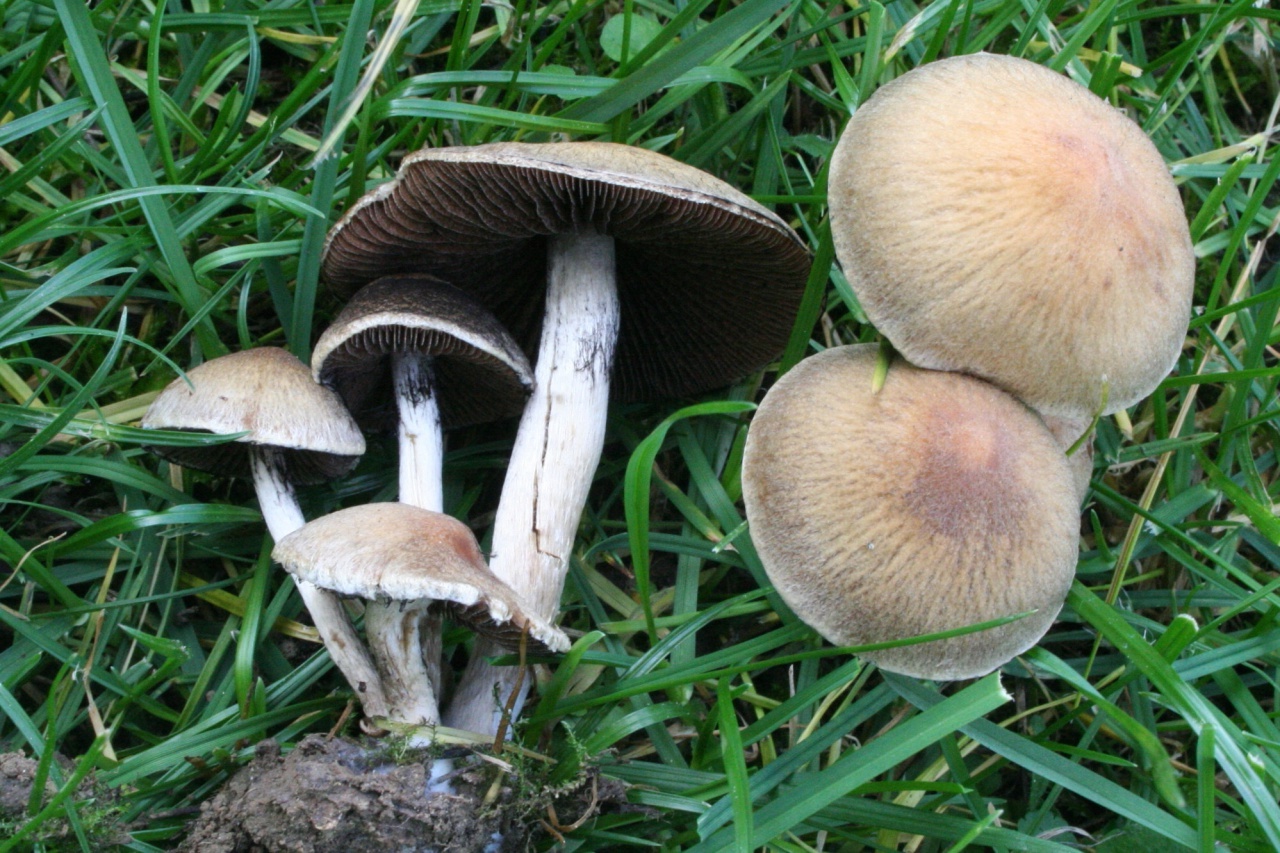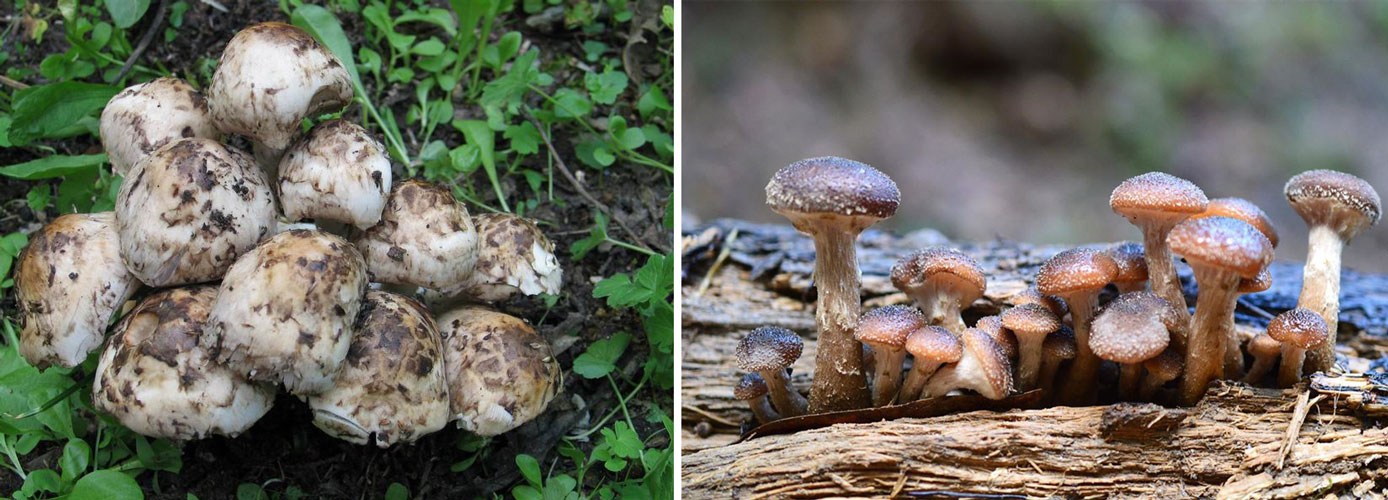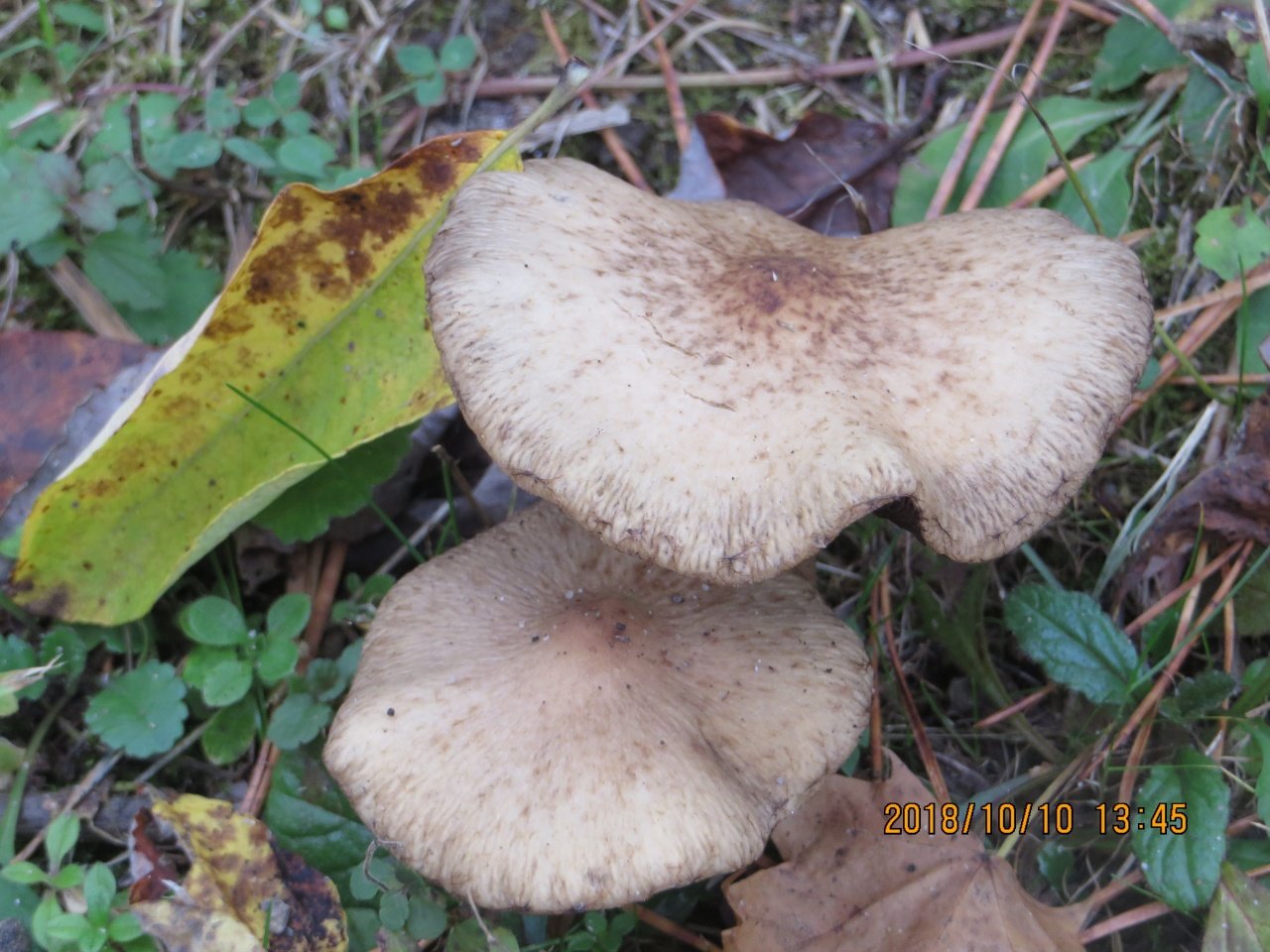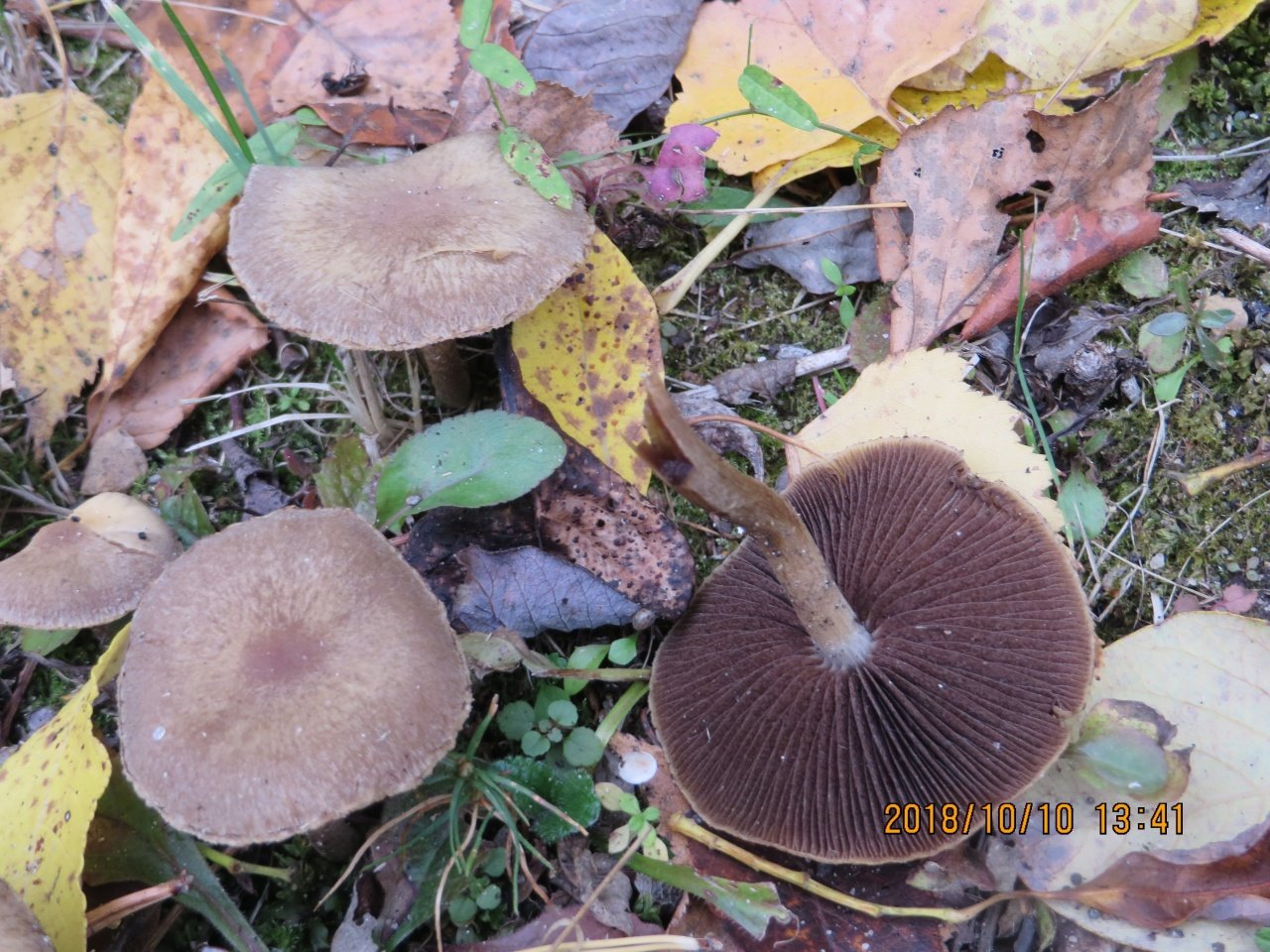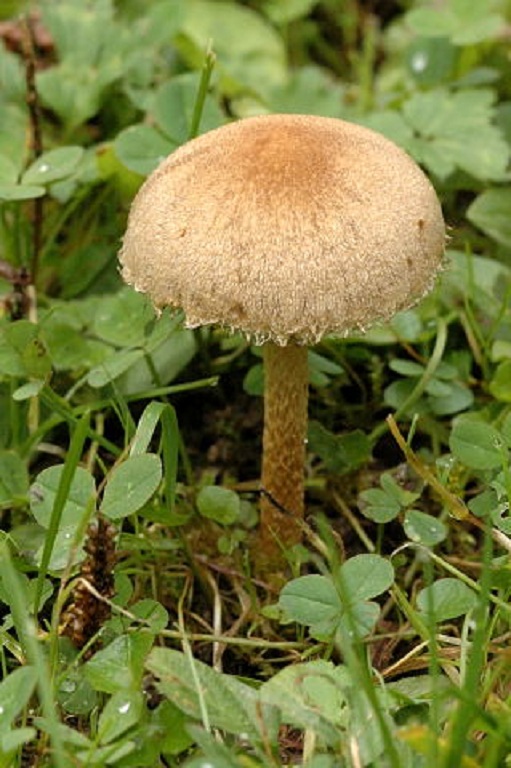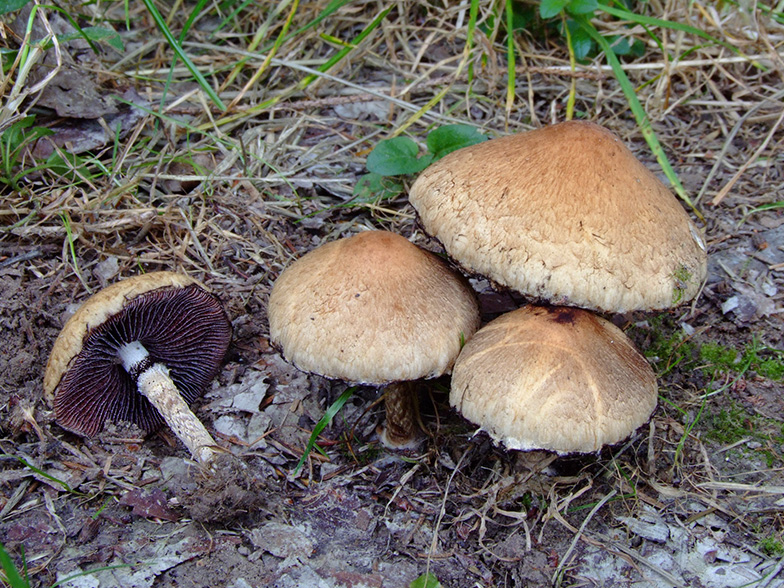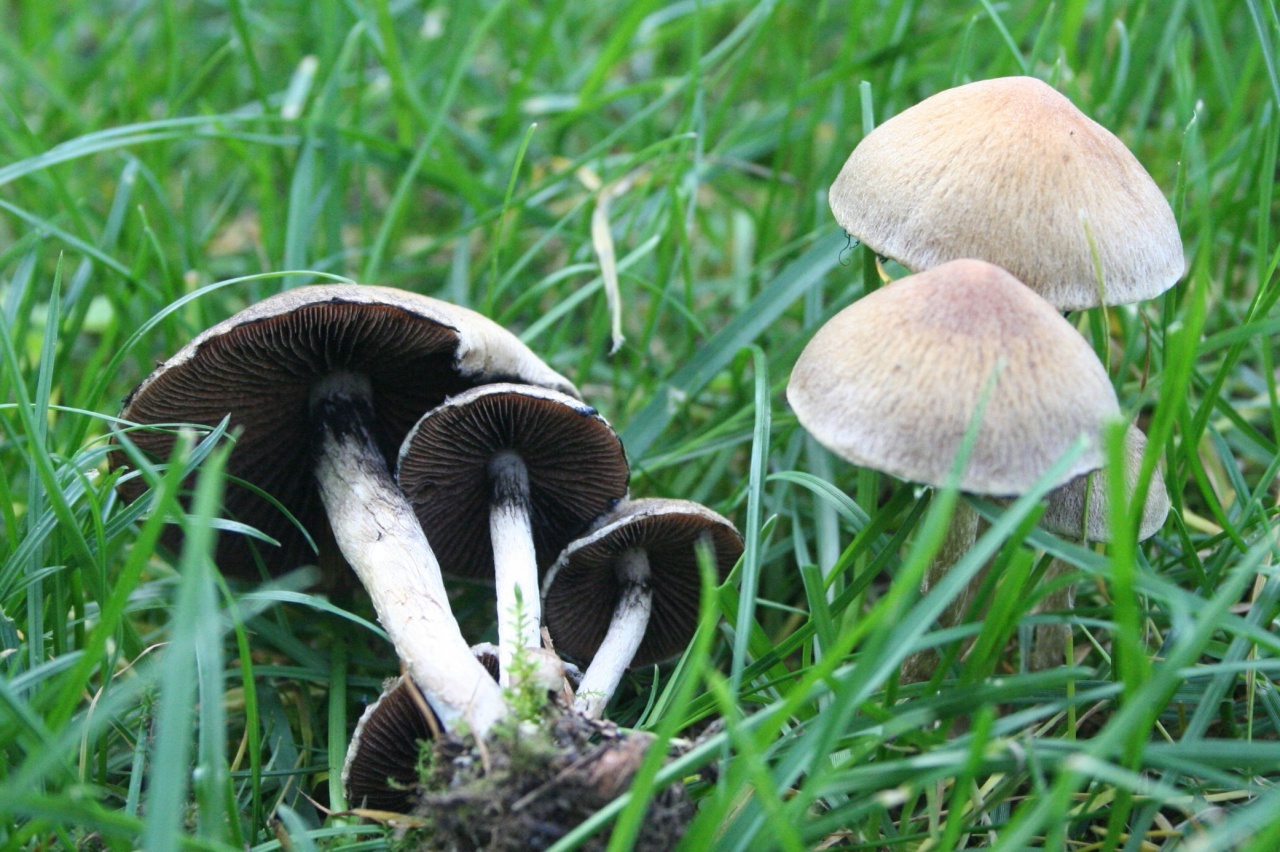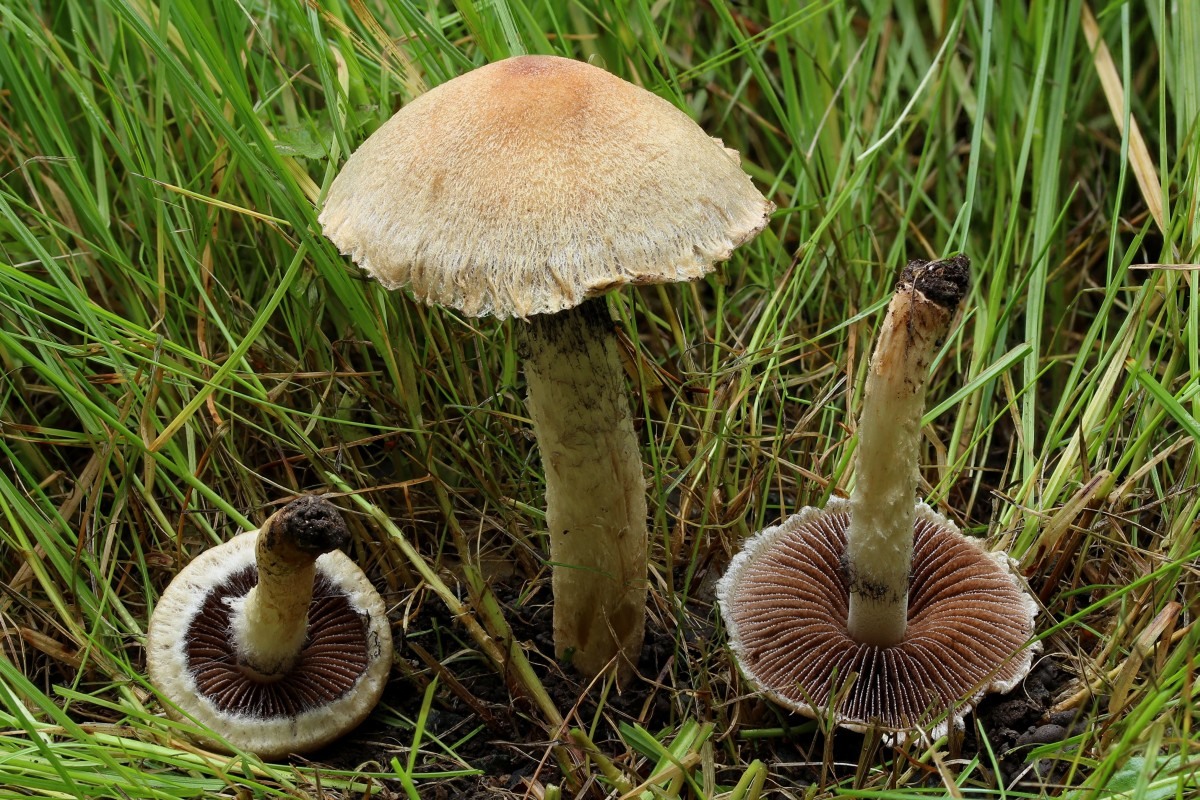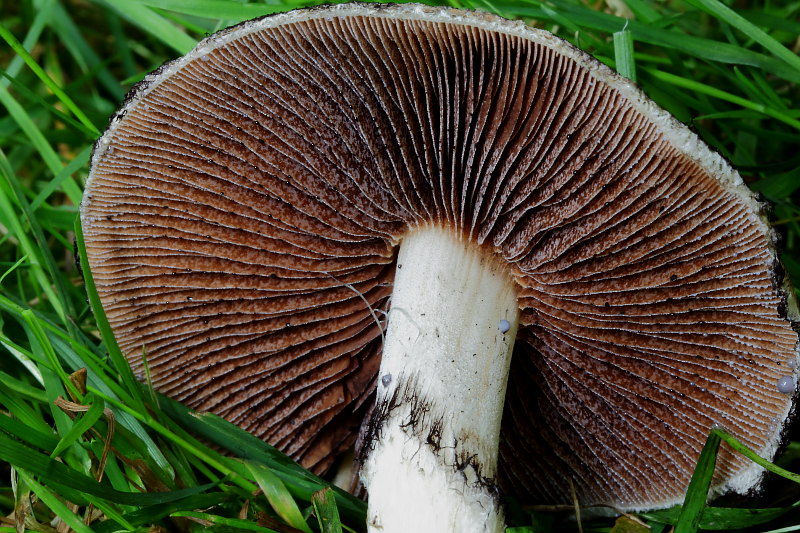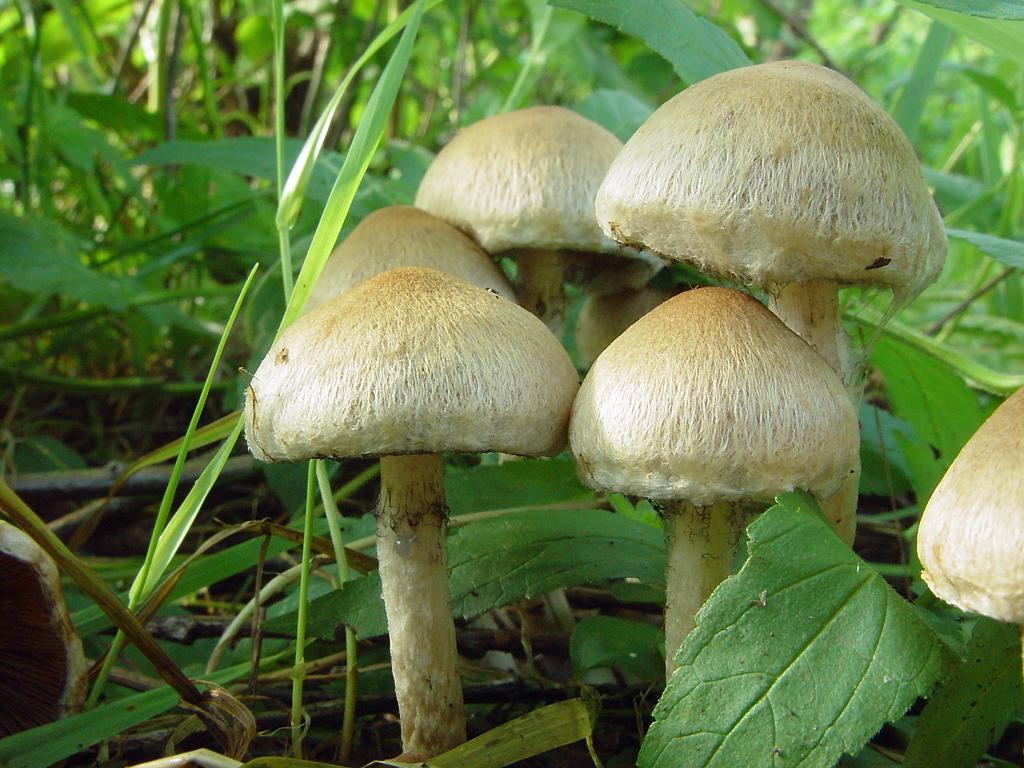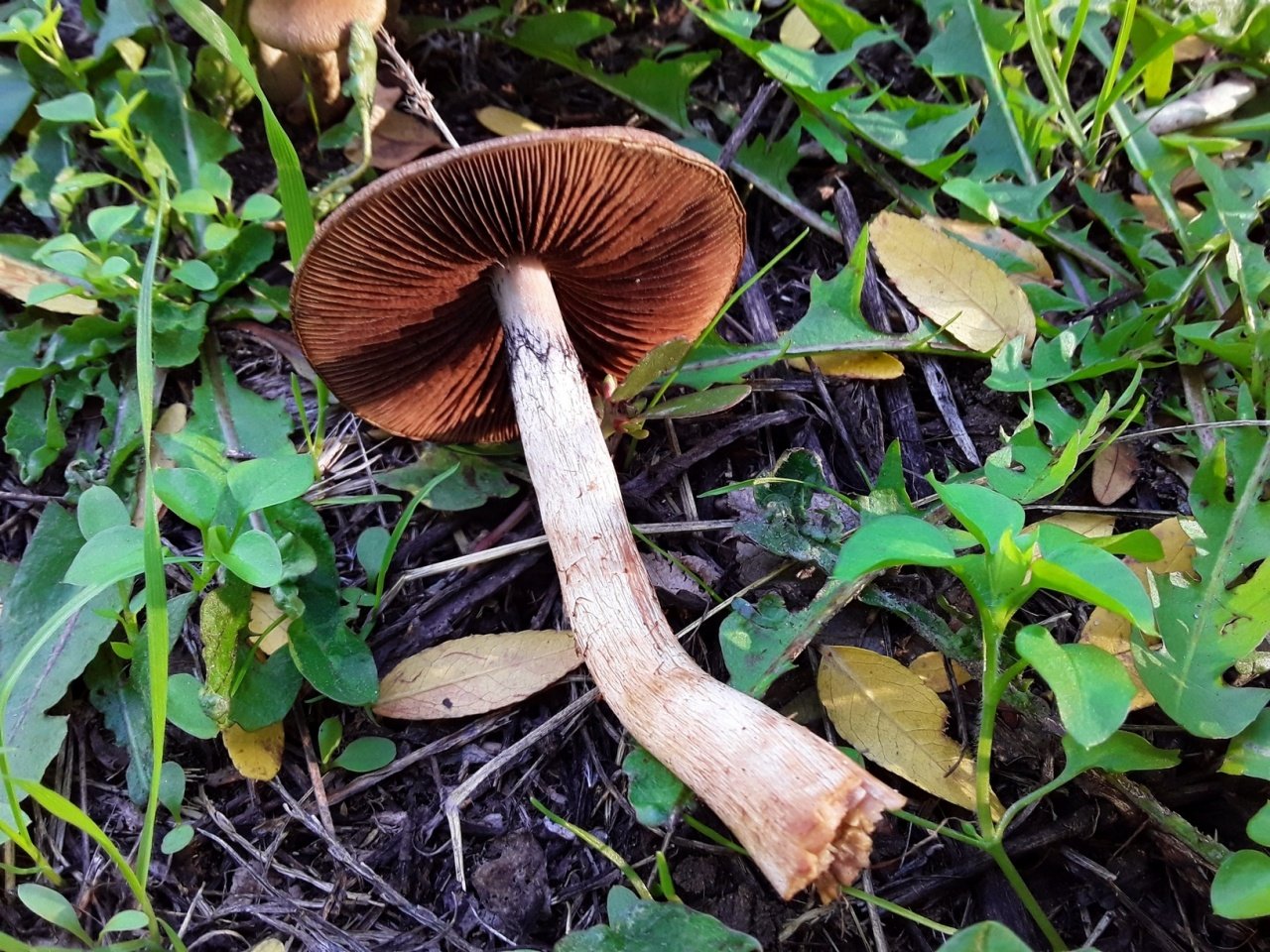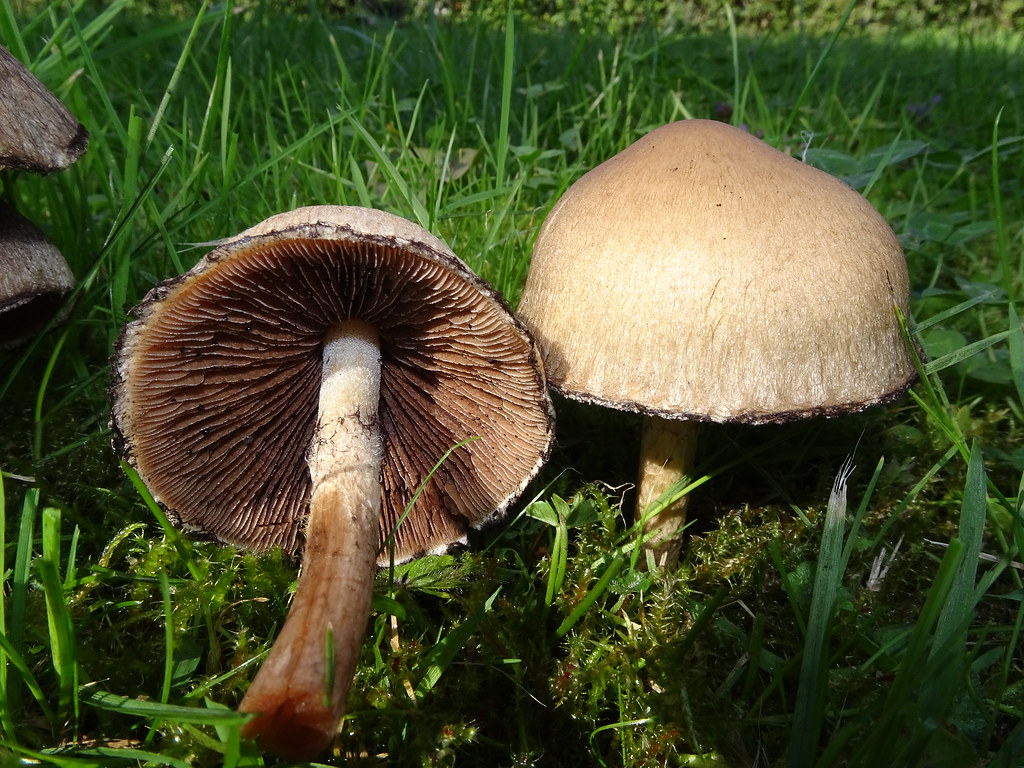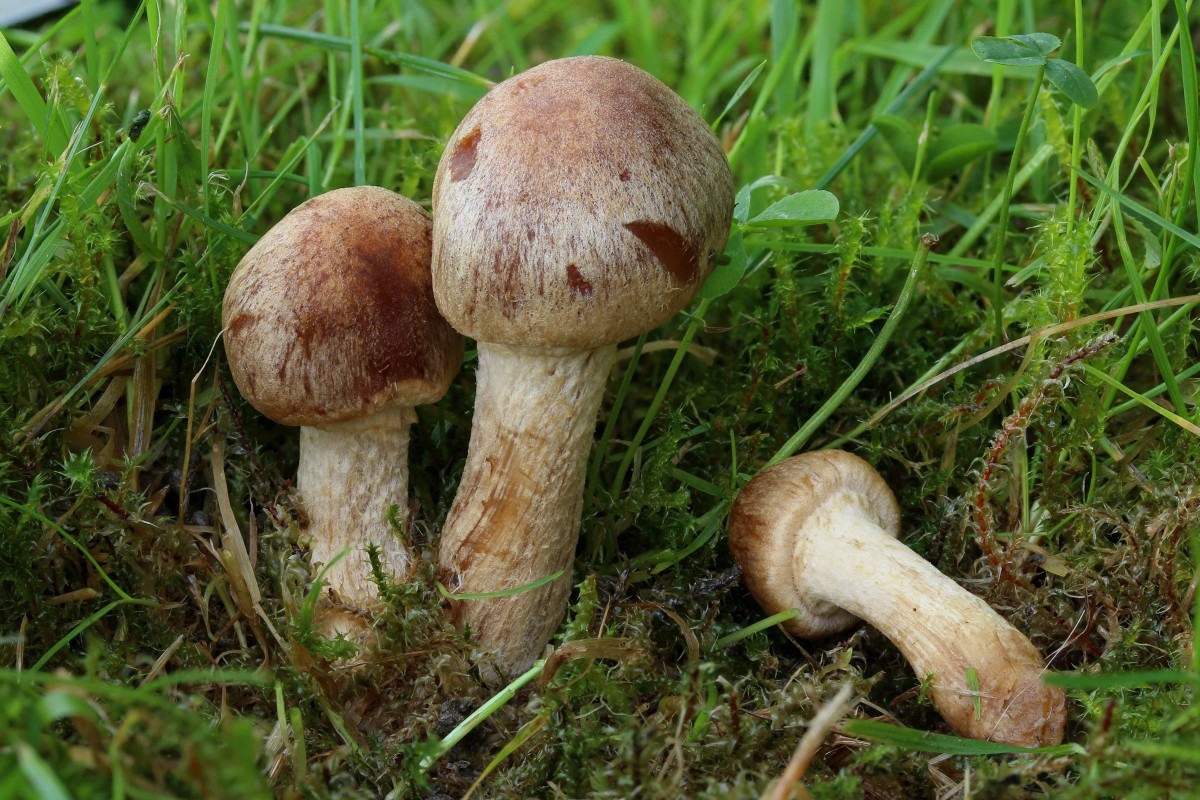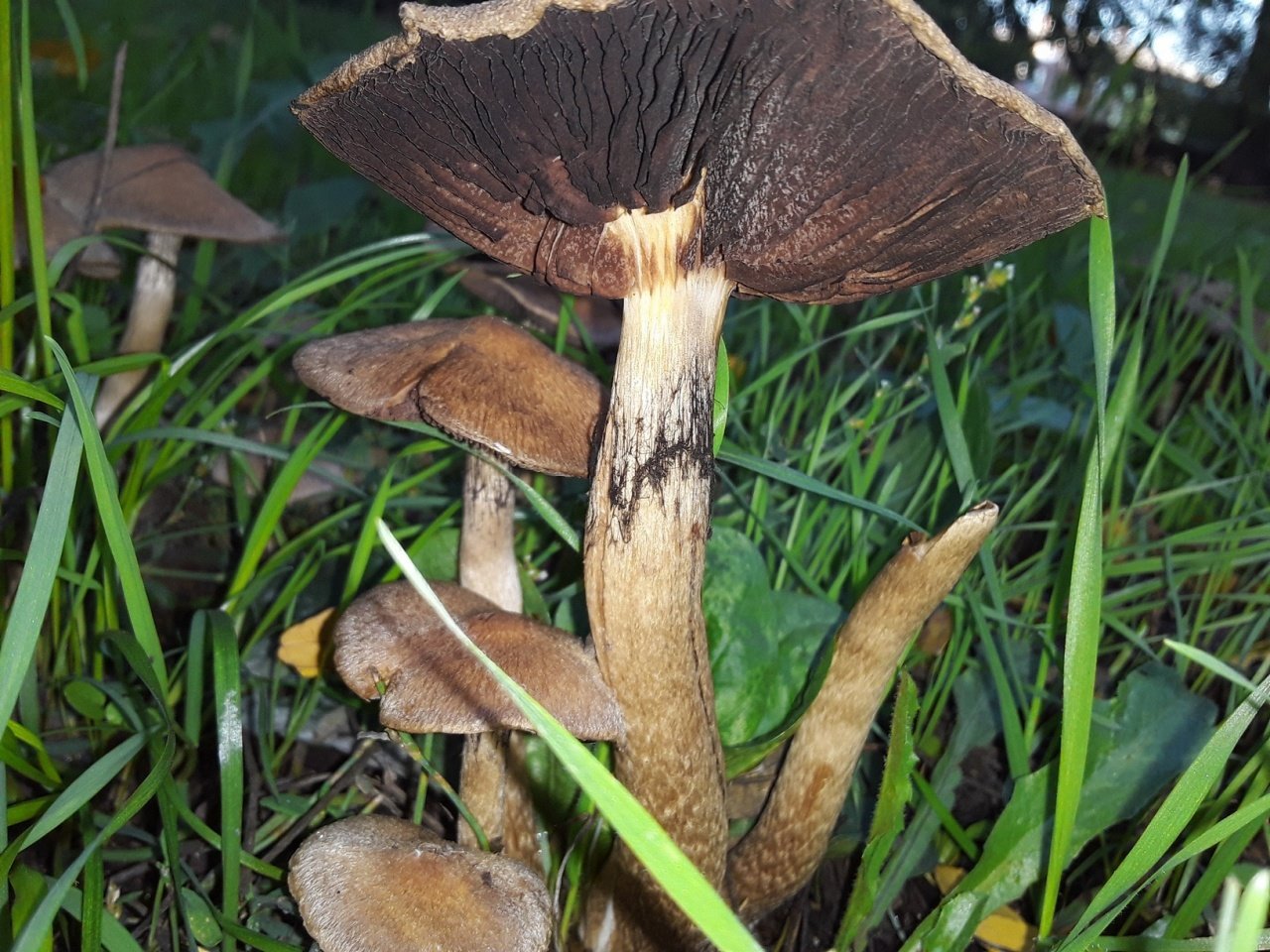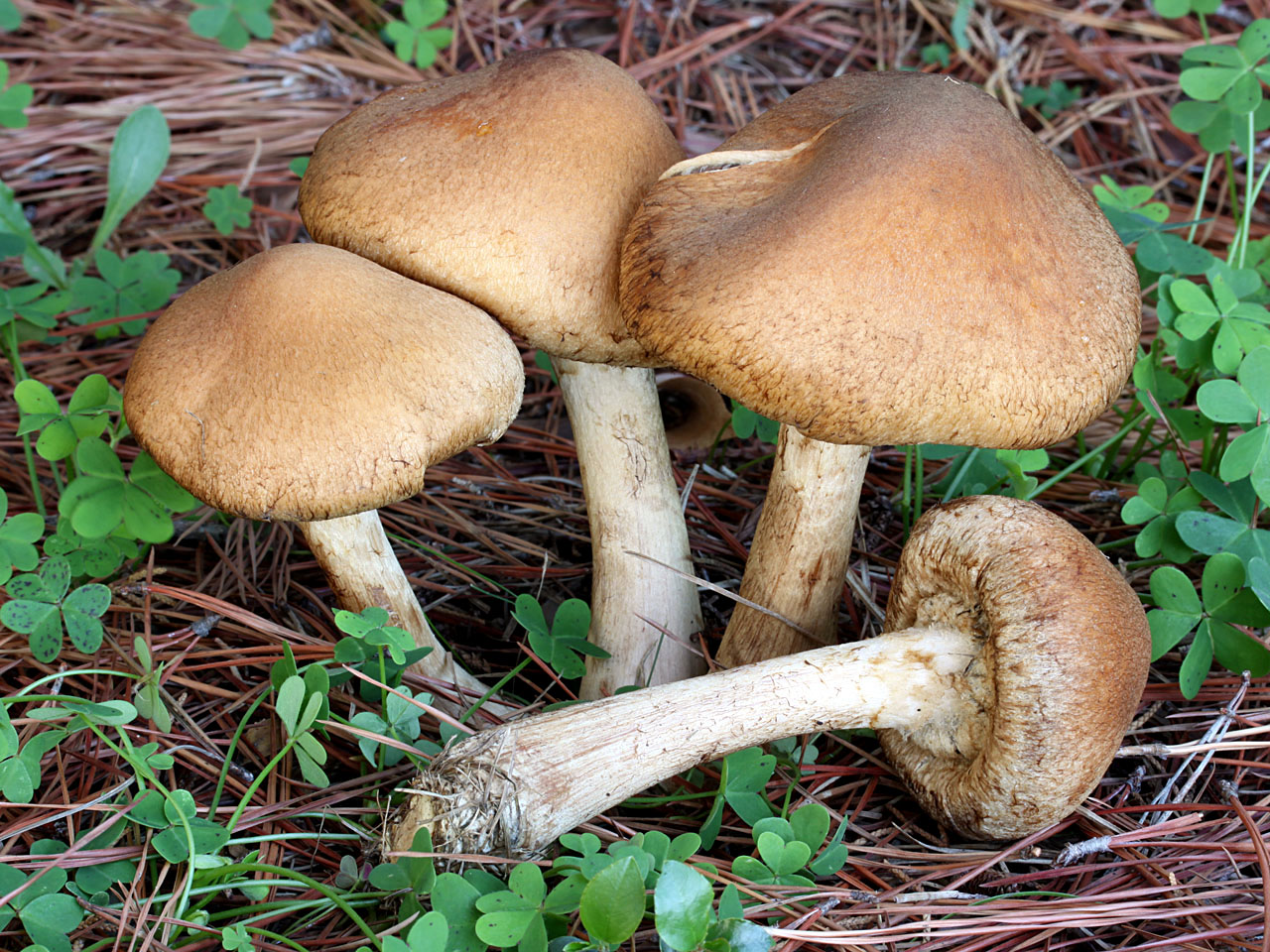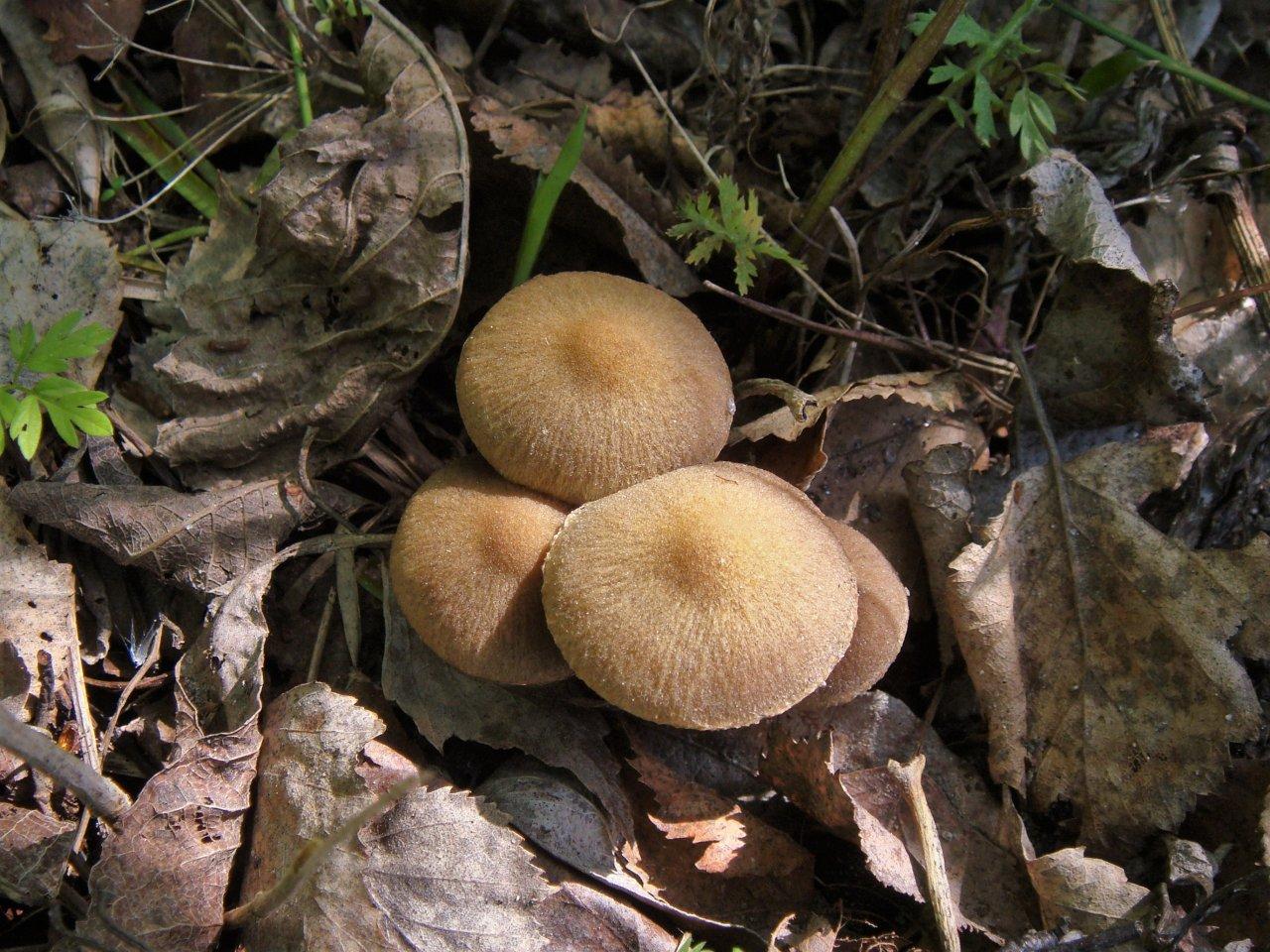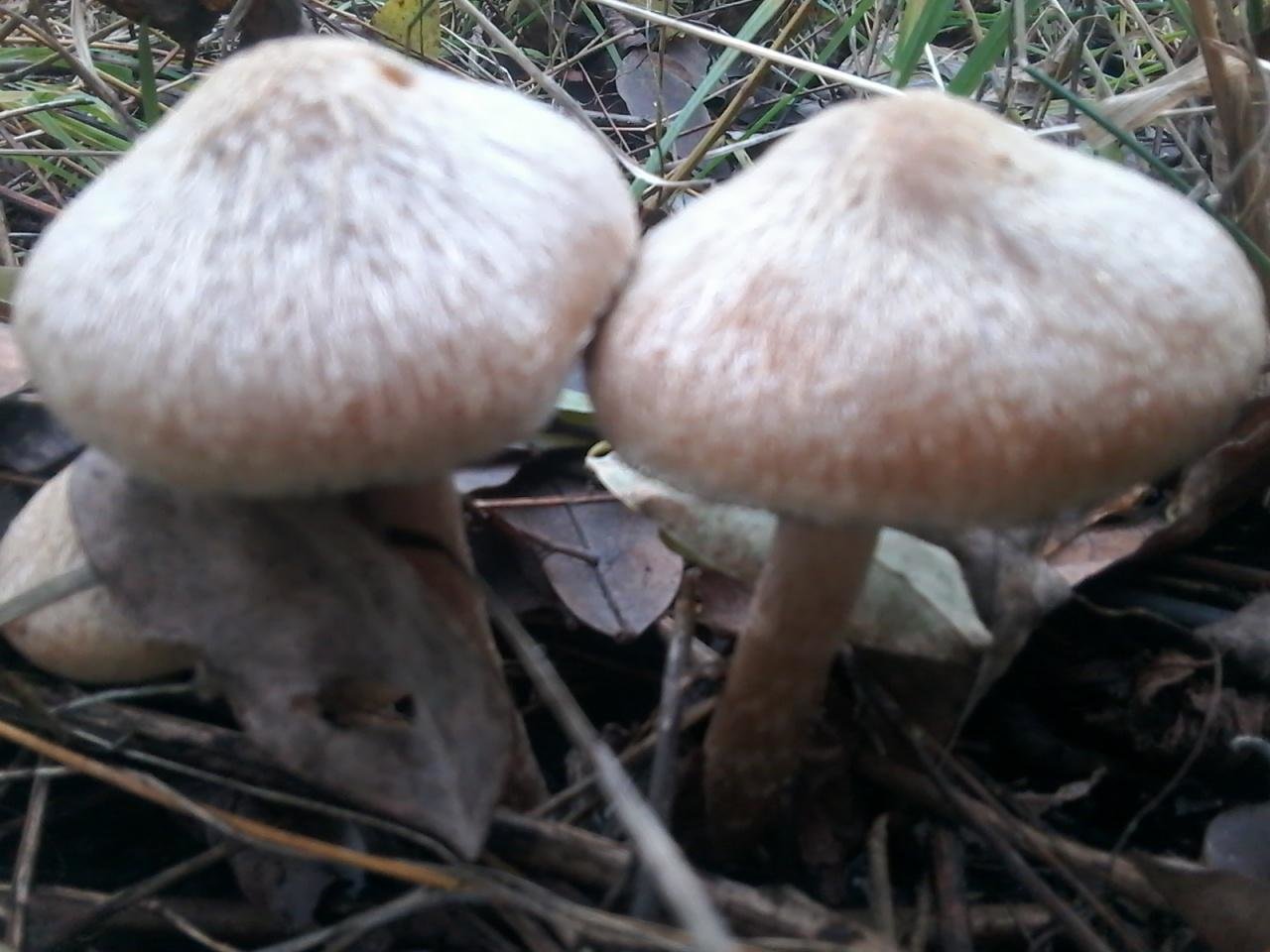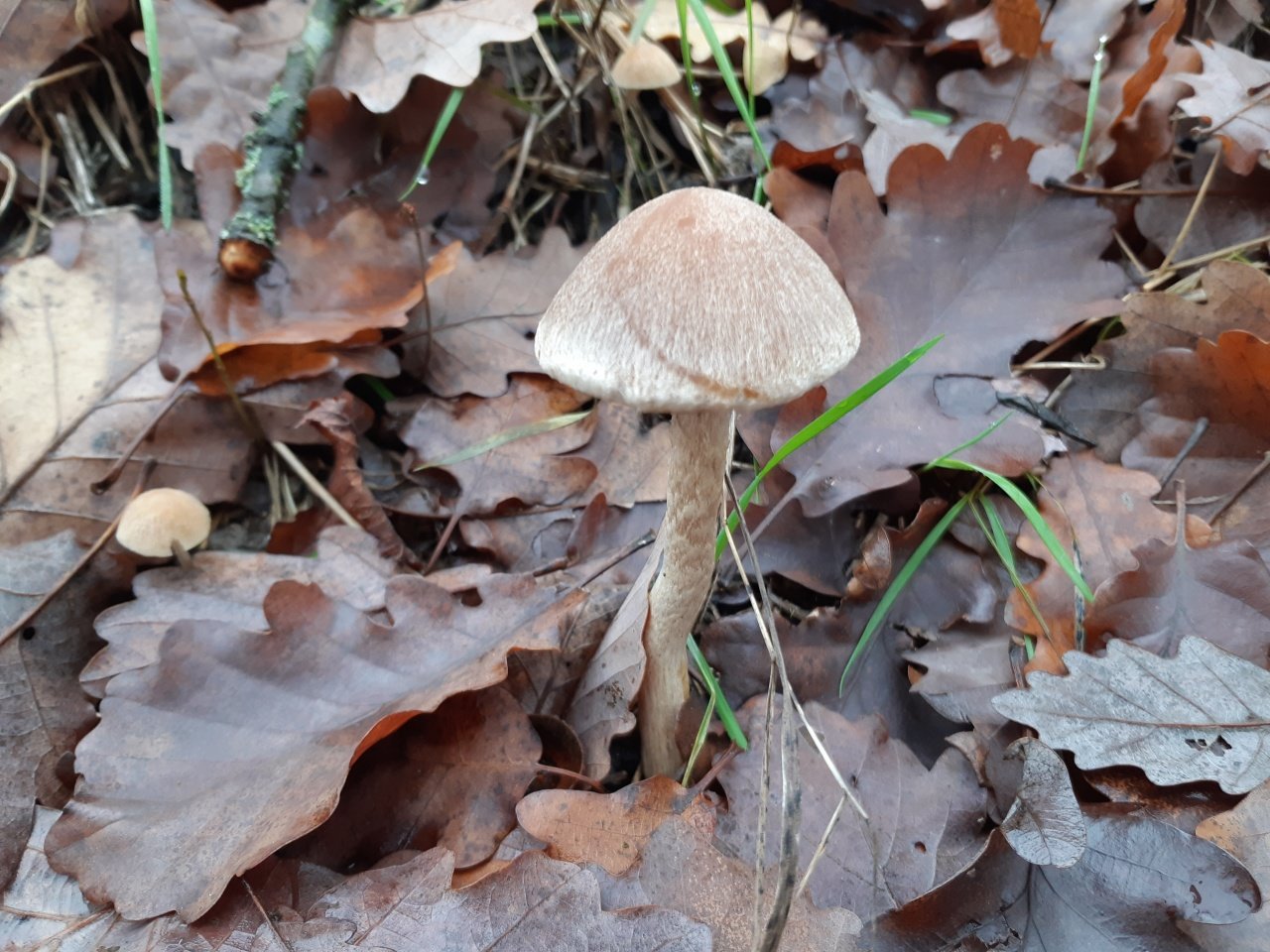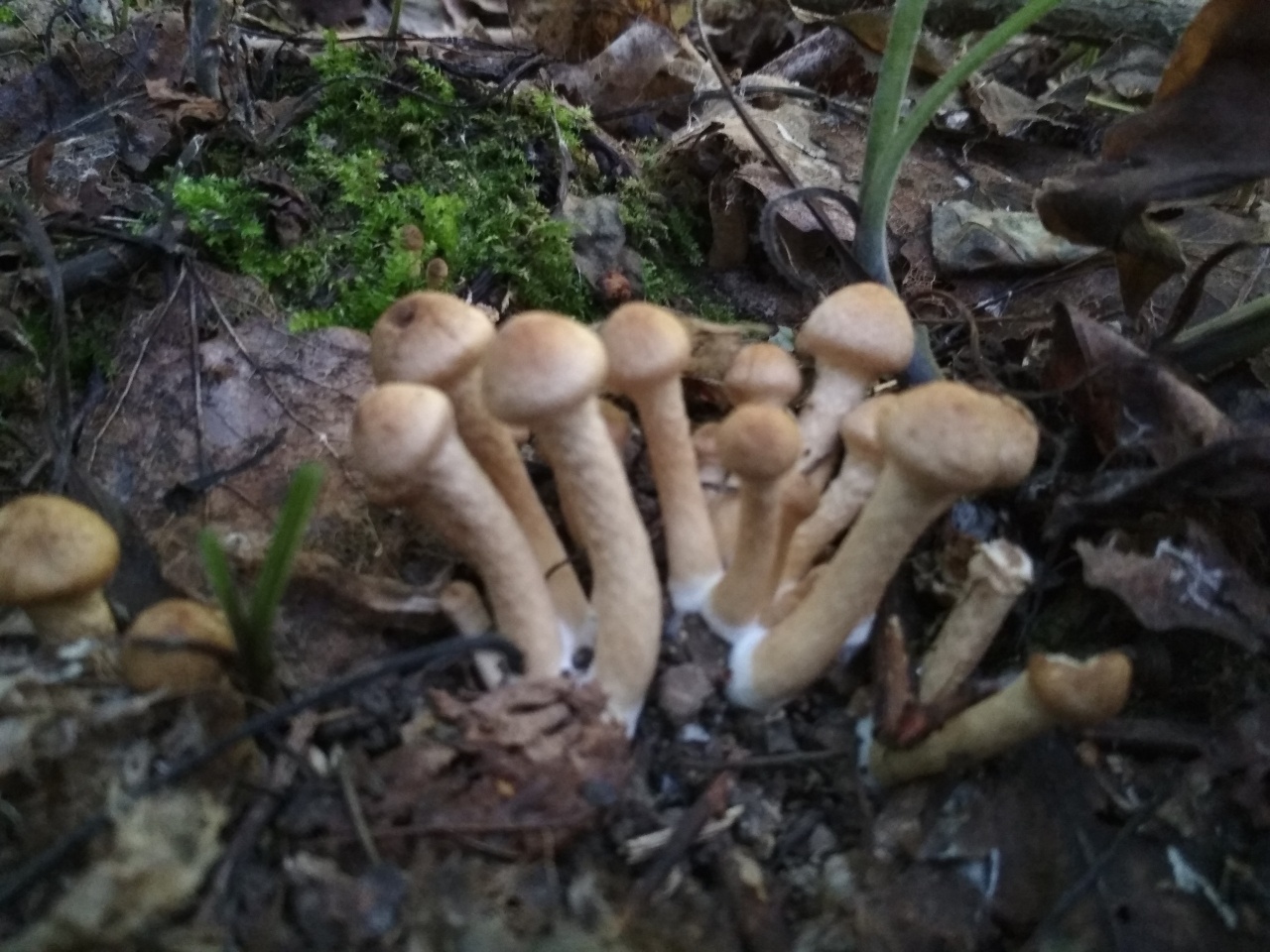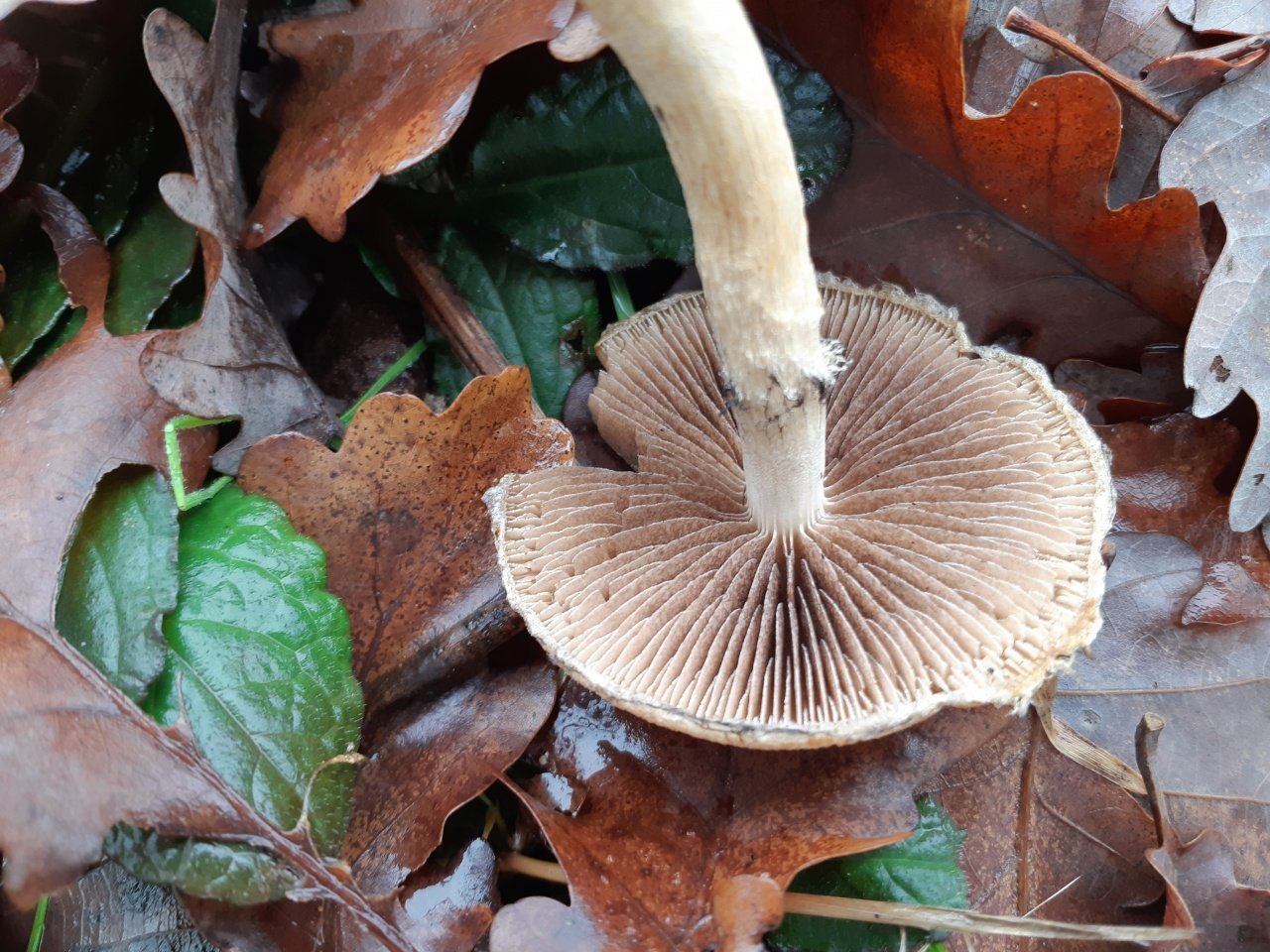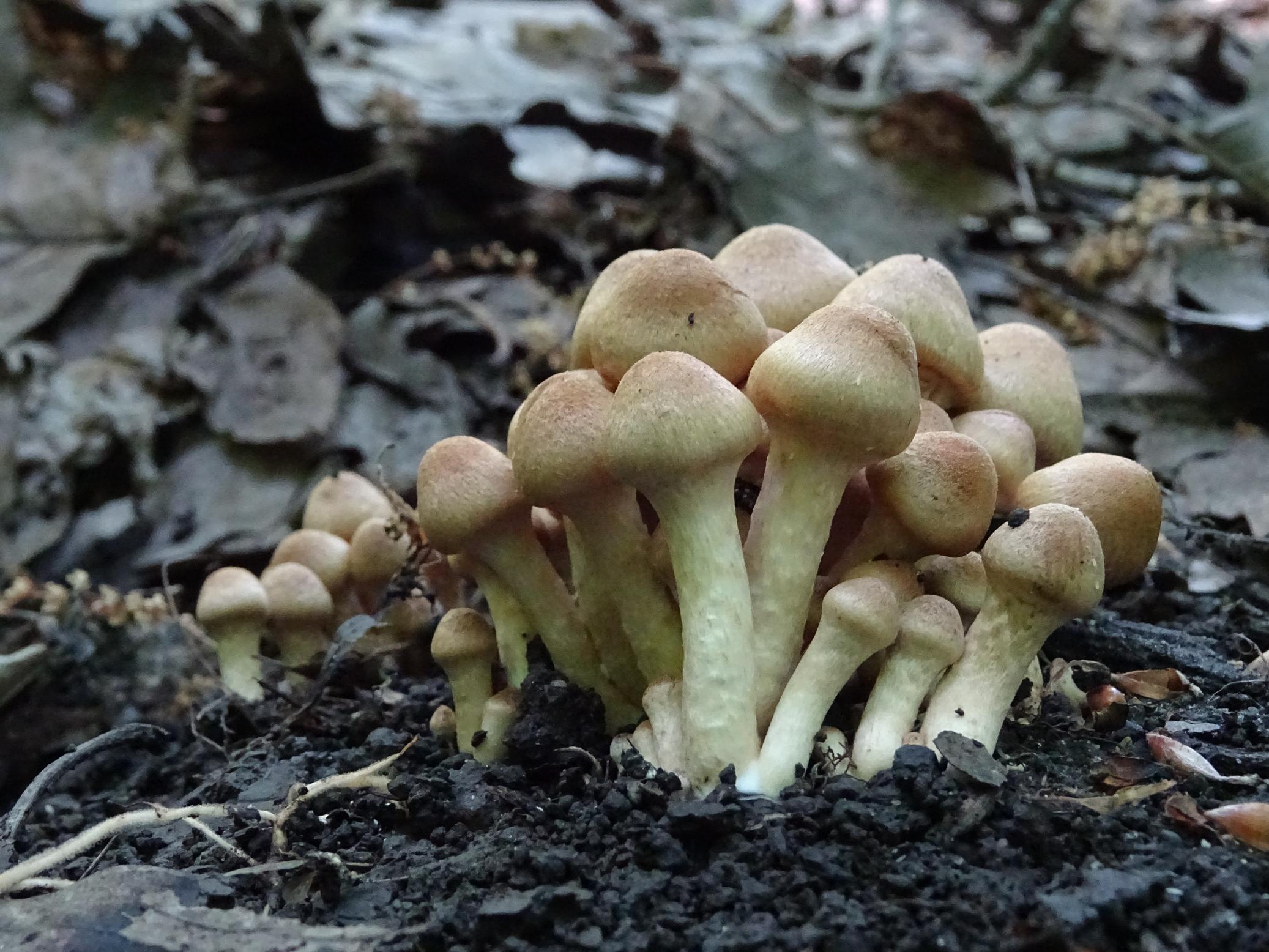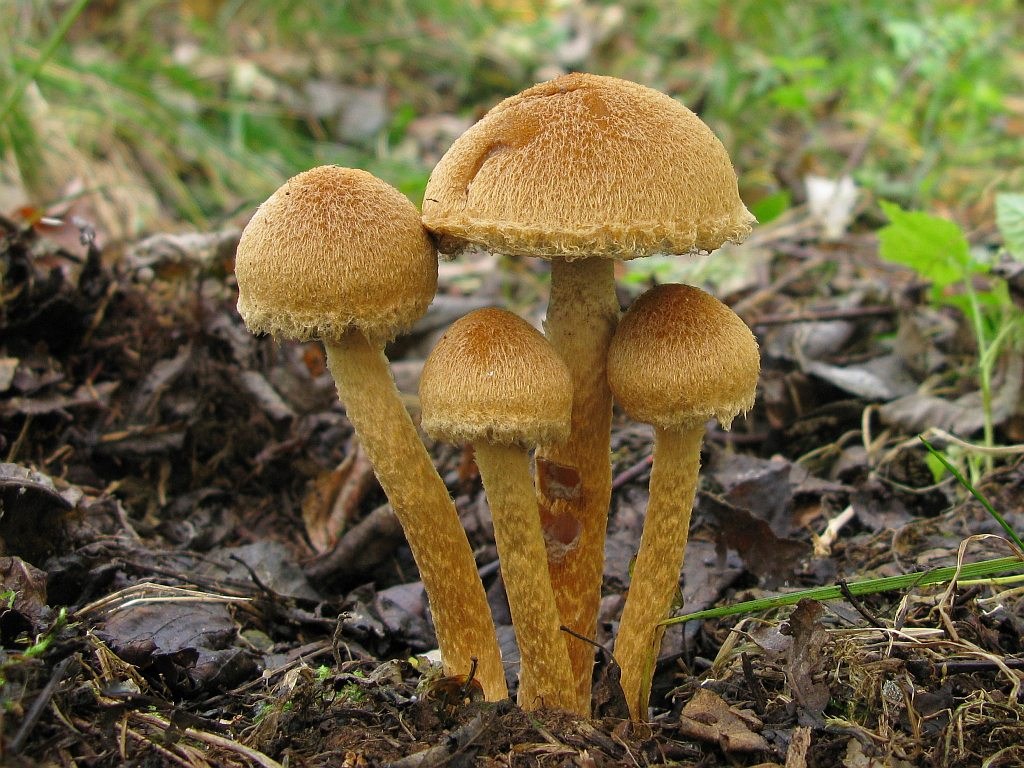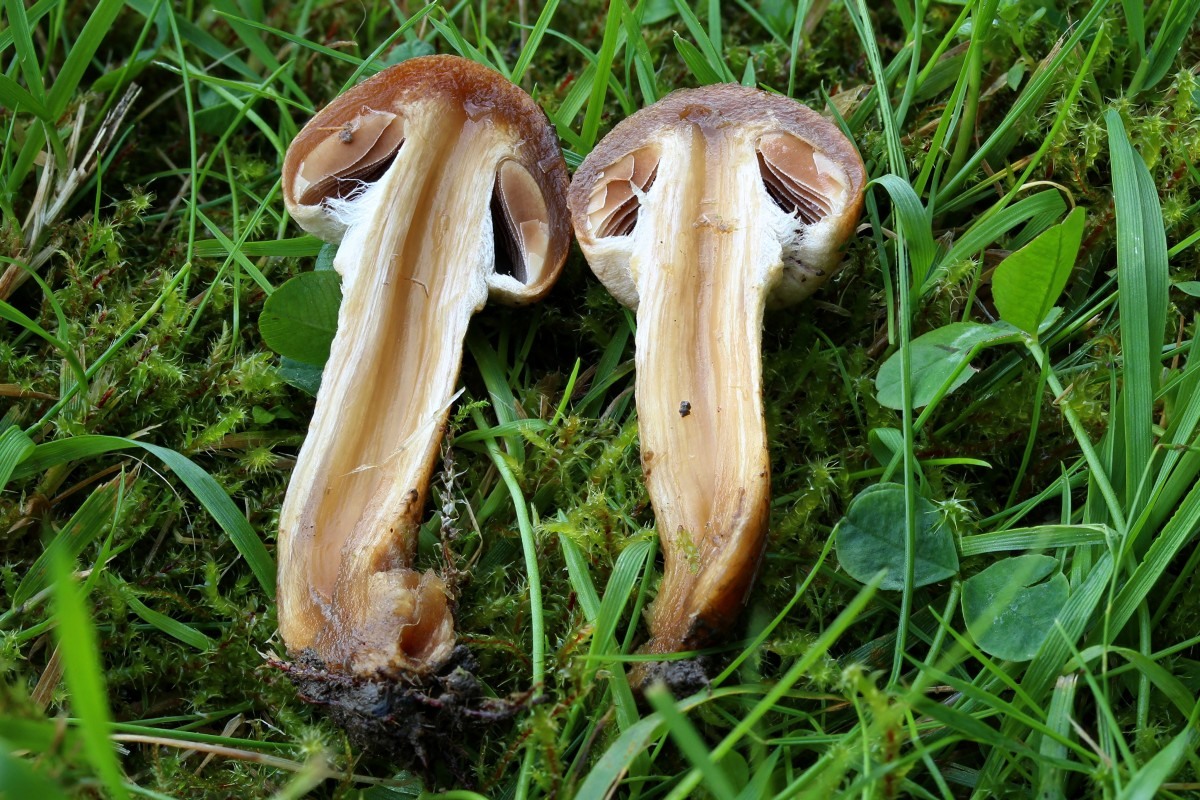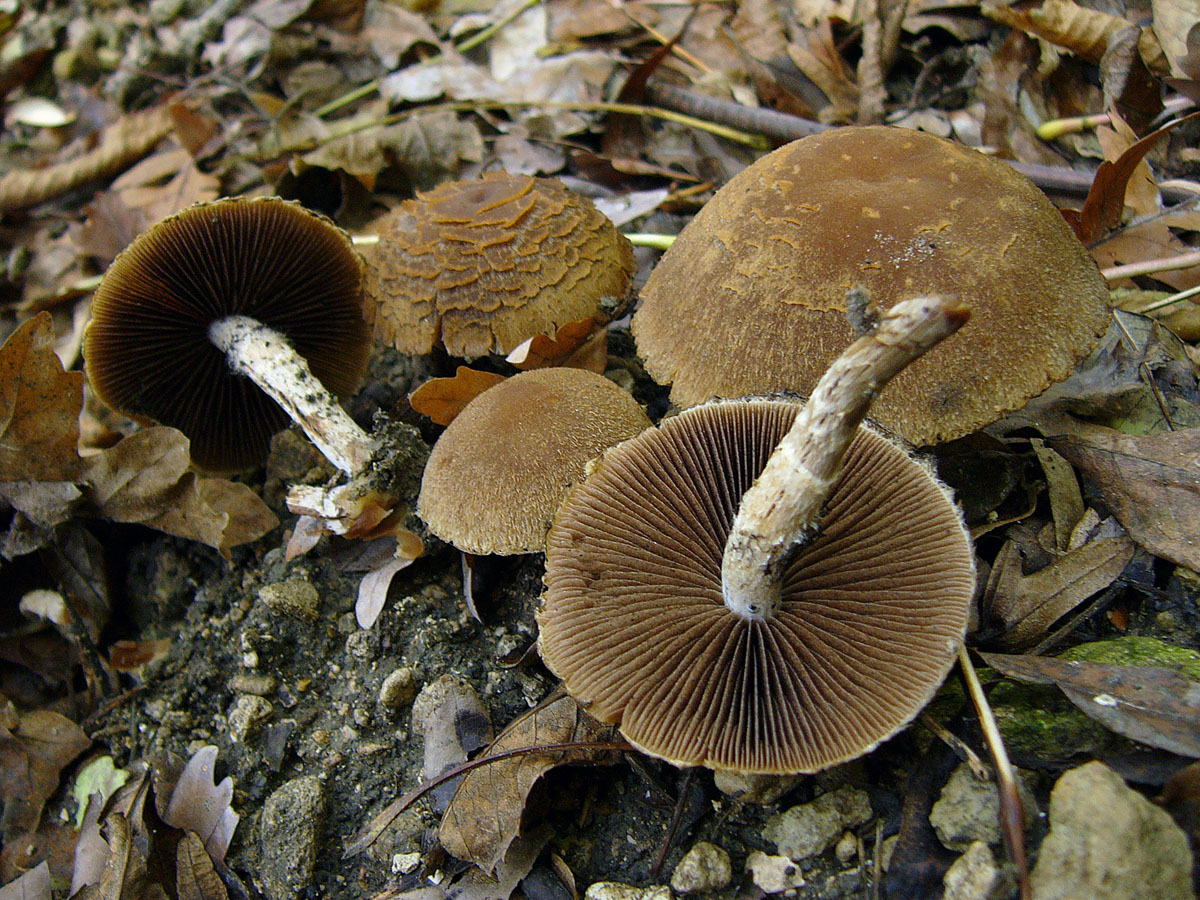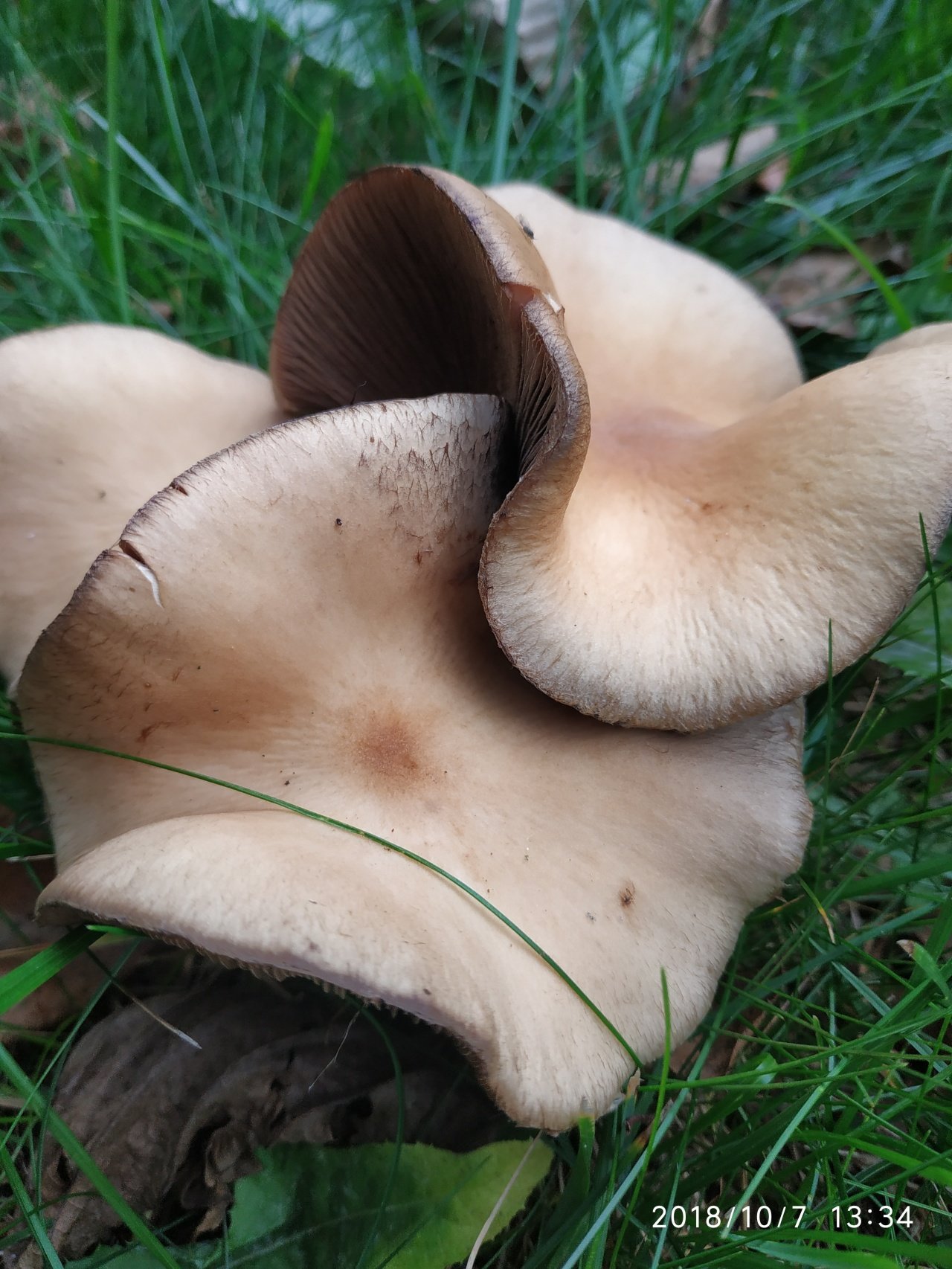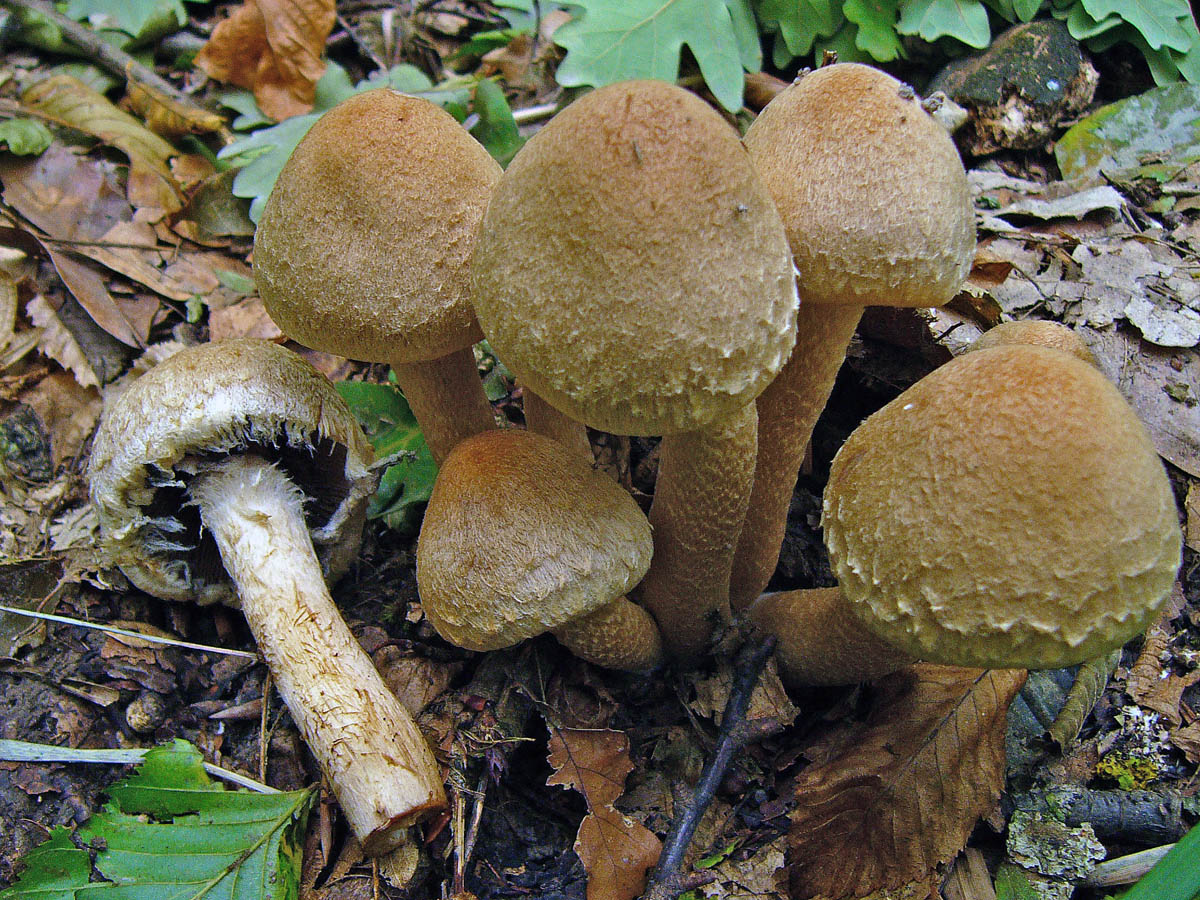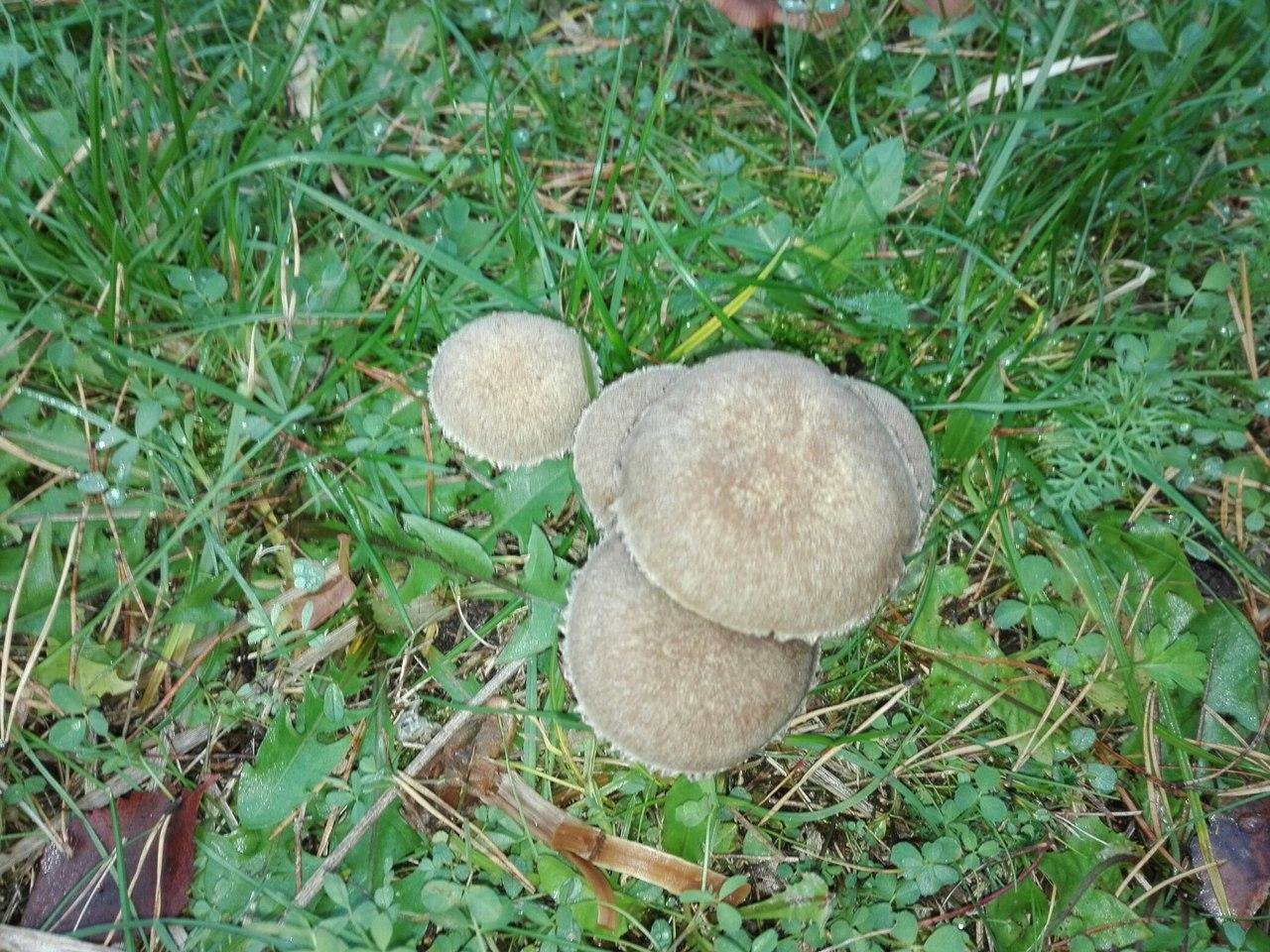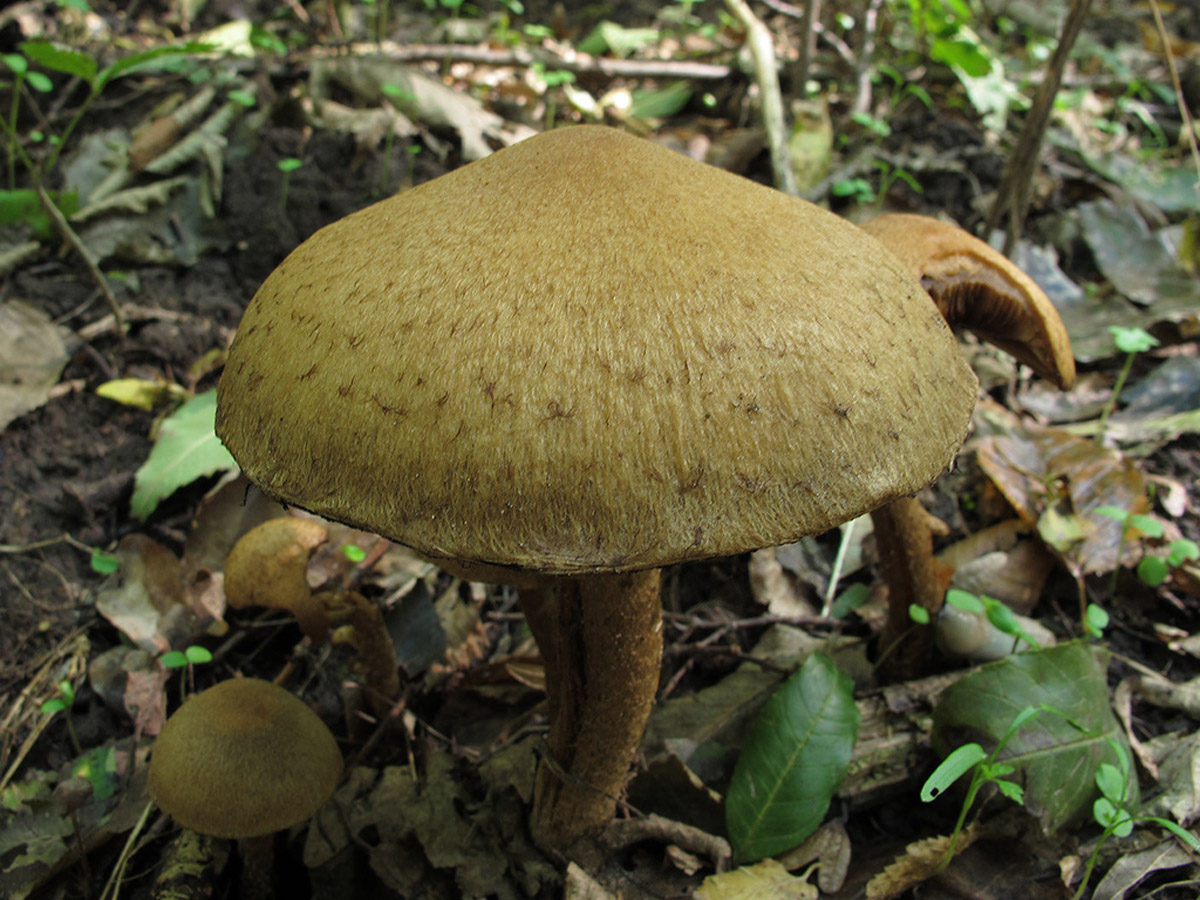Description of psatirella Candoll
In a young psatirella Candoll, the cap has a bell-shaped shape, over time it becomes relatively open, while a smooth slight elevation remains in the center. The diameter of the cap ranges from 3 to 7 centimeters. The color of the cap varies from white to yellow-brown. Along the edges of the cap there are specific flakes, which are the remains of the bedspread.
The pulp is brittle, thin, whitish-brown in color. The pulp has a pleasant mushroom aroma. The plates of young fruiting bodies are grayish in color; as the fungus matures, they become darker and reach a dark brown color. The plates are densely planted, they grow to the stem.
Spore powder of purple-brown color, almost black. The leg is cylindrical, hollow, with a small fluff at the bottom. The color of the leg is whitish-cream. The leg length is 7-10 centimeters with a thickness of 0.4-0.8 centimeters.
Spread of Candoll's false-horns
These mushrooms bear fruit from May until autumn. They grow in deciduous and mixed forests, as well as in parks and gardens. You can find Candoll's psatirella on the stumps and roots of deciduous trees. They grow in numerous groups.
With the onset of summer, Candoll's false heaps begin to compete for territory with shimmering dung beetles. And the dung beetles win, they choose the sunny side, and Candoll's psatirella grows in the shade.
Edible psatirella Candoll
Psatirella Candolla in old sources was referred to as inedible and even poisonous species, but today it is believed that they can be eaten after prolonged boiling, therefore they are classified as conditionally edible mushrooms.
Similarity to other mushrooms
A distinctive feature of Candoll's mushroom is the remains of the bedspread present on the edges of the cap. But sometimes the remains of the bedspread are not preserved, in this case Candoll's psatirella is distinguished from different types of champignons by the places of growth - the former grows on dead wood, in numerous groups. In addition, Candoll's mushroom does not have a clearly defined ring on the leg.
Psatirella Candolla differs from representatives of the genus Agrocybe in a darker color of spore powder. But it should be borne in mind that Candoll's mushrooms are very changeable mushrooms, they can have completely different colors, which depends on the temperature, humidity and places where the fruit chalk grows. However, Candoll's mushrooms are completely different from the popular, edible mushrooms.
Other mushrooms of this genus
Psatirella gray-brown has a spherical cap at a young age, but then it opens and becomes almost prostrate. The hat is small - 3-6 centimeters in diameter. In young mushrooms, the edges of the caps are covered with a fringe, which is the remnants of a bedspread.
In dry weather, the caps often crack. A small tubercle sometimes remains in the center of the cap, but it can be seen very rarely, as a rule, in thin-fleshy fruit chalk. The color of the cap is very variable, it depends on the weather conditions. In color, any shades of brown and gray can be observed. In dry weather, the cap generally fades and turns yellow. The height of the leg is 4-8 centimeters, and the diameter reaches 0.8 centimeters, which is quite a lot in comparison with other types of psatirella. The leg is flat, cylindrical, whitish in color, its surface is covered with scales.
Psatirella gray-brown begins to bear fruit in early May. These mushrooms grow on decaying wood. They settle in rather scattered groups, sometimes they can grow together. Fruiting occurs in waves, the last stage is observed in mid-October. The fungus is an edible member of the genus.
Psatirella is water-loving, she is spherical psatirella has a cap with a diameter of 2-5 centimeters. The pulp is thin, watery, brown in color, with a bitter taste, without a pronounced odor.
Psatirella water-loving bears fruit from September to November.Inhabits the remains of deciduous wood, in a more rare case, it is found on needles. This is an inedible species.
As it grows, the cap changes from bell-shaped to almost flat, with a rounded tubercle in the central part and cracking edges. The skin is dry, smooth. The color of the cap is dark brown or yellow-brown. The length of the leg is 4-8 centimeters, with a diameter of 0.5-0.8 centimeters. The leg is hollow inside, often curved. The surface of the leg is silky, its lower part is light brown with a powdery coating of white.
Psatirella velvety
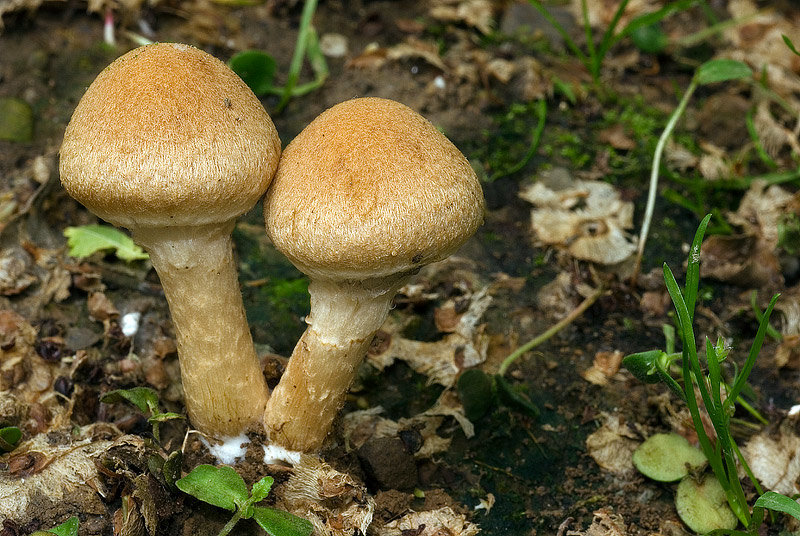
Psathyrella lacrymabunda
- Lacrimaria is velvety;
- Felt lacrimaria;
- Psathyrella velutina;
- Lacrymaria lacrimabunda;
- Lacrymaria velutina.
External description
The fruiting body of the velvety psatirella is hat-peg. The caps of this mushroom are 3-8 cm in diameter, in young mushrooms they are hemispherical, sometimes bell-shaped. In mature mushrooms, the cap becomes convex-outstretched, velvety to the touch; the remnants of the bedspread are clearly visible along the edges of the cap. The flesh of the cap is fibrous and scaly. Sometimes the caps of the velvety psatirella are radially wrinkled, and can be brownish-red, yellow-brown, or ocher-brown in color. The middle of these mushrooms is chestnut brown.
The leg of a velvety psatirella can be from 2 to 10 cm in length, and does not exceed 1 cm in diameter. The shape of the leg is mostly cylindrical. From the inside, the leg is empty, slightly widened at the base. Its texture is fibrous-felt and its color is off-white. The fibers are brown. Young mushrooms have a peri-pectoral ring that disappears over time.
The mushroom pulp is whitish in color, sometimes giving off yellow. At the base of the leg, the flesh is brown. In general, the pulp of this type of mushroom is brittle, saturated with moisture.
The hymenophore in psatirella velvety is lamellar. The plates, located under the cap, grow to the surface of the leg, have a grayish tint and are often located. In mature fruiting bodies, the plates become dark brown, almost black, and always have light edges. In immature fruiting bodies, droplets appear on the plates.
The spore powder of psatirella velvety has a brownish-purple color. Spores are lemon-shaped, warty.
Season and habitat of the mushroom
Fruiting of velvety psatirella (Psathyrella lacrymabunda) begins in July, when solitary mushrooms of this species appear, and its activity increases significantly in August and continues until early September.
From mid-summer to about October, velvety psatirella can be found in mixed, deciduous and open places, on soils (often sandy), in grass, near roadsides, on rotten wood, near forest paths and roads, in parks and squares, in gardens and cemeteries. It is not often possible to meet mushrooms of this type in Russia. Velvety psatirellas grow in groups or singly.
Edibility
Psatirella velvety is one of the conditionally edible mushrooms. It is recommended to use it fresh for preparing second courses. This mushroom is boiled for 15 minutes, and the broth is poured out. However, some experts in the field of mushroom growing believe that velvety psatirella is an inedible and highly poisonous mushroom.
Similar types and differences from them
In appearance, velvety psatirella (Psathyrella lacrymabunda) is similar to cotton wool psatirella (Psathyrella cotonea). However, the second type of mushroom has a lighter shade, and in an immature form, it is whitish. Wadded psatirella grows mainly on decaying wood, characterized by a hymenophore with red-brown plates.
Other information about the mushroom
Psatirella velvety is sometimes referred to as an independent genus of mushrooms Lacrymaria, which translates from Latin as "tear". This name was given to the mushroom because droplets of liquid, very similar to tears, often accumulate on the plates of the hymenophore in young fruit bodies.
Mushroom photo Psatirella velvety from questions in recognition:
Accepted views
- Psathyrella aquatica J.L. Frank, Coffan, & Southworth 2010
- Psathyrella ammophila (Durieu & Lév.) P. D. Orton 1960
- Psathyrella asperospora (Cleland) Guzmán, Bandala & Montoya 1991
- Psathyrella atomatoides (Peck) A. H. Sm. 1972
- Psathyrella atrolaminata Kits van Wav. 1981
- Psathyrella badiovestita P. D. Orton 1960
- Psathyrella bifrons (Berk.) A. H. Sm. 1941
- Psathyrella bipellis (Quél.) A. H. Sm. 1946
- Psathyrella borgensis Kits van Wav. 1987
- Psathyrella candolleana (Fr.) Maire 1913 - Psathyrella Candolle
- Psathyrella canoceps (Kauffman) A. H. Sm. 1941
- Psathyrella caput-medusae (Fr.) Konrad & Maubl. 1948
- Psathyrella cernua (Vahl) M. M. Moser 1984 - Fragile drooping
- Psathyrella chondroderma (Berk. & Broome) A. H. Sm. 1941
- Psathyrella clivensis (Berk. & Broome) P. D. Orton 1960
- Psathyrella conopilus (Fr.) A. Pearson & Dennis 1949 - Fragile conical, or Psatirella blackish
- Psathyrella coprophila Watling 1971
- Psathyrella corrugis (Pers.) Konrad & Maubl. 1948 - Fragile wrinkled
- Psathyrella cotonea (Quél.) Konrad & Maubl. 1949
- Psathyrella dennyensis Kits van Wav. 1987
- Psathyrella dunensis Kits van Wav. 1985
- Psathyrella echinata (Cleland) Grgur. 1997
- Psathyrella fatua (Fr.) P. Kumm. 1949 - Tasteless fragile
- Psathyrella fibrillosa (Pers.) Maire 1938 - Psathyrella fibrillosa
- Psathyrella flexispora T. J. Wallace & P. D. Orton 1960
- Psathyrella friesii Kits van Wav. 1977
- Psathyrella frustulenta (Fr.) A. H. Sm. 1941
- Psathyrella fusca (Schumach.) M. M. Moser 1952
- Psathyrella gordonii (Berk. & Broome) A. Pearson & Dennis 1948 - Psatirella Gordon
- Psathyrella gossypina (Bull.) A. Pearson & Dennis 1948 - Cotton Psathyrella
- Psathyrella gracilis (Fr.) Quél. 1872 typus - Psatirella graceful, or Fragile slender
- Psathyrella hirta Peck 1897
- Psathyrella incerta (Peck) A. H. Sm. 1972
- Psathyrella laevissima (Romagn.) Singer 1969
- Psathyrella leucotephra (Berk. & Broome) P. D. Orton 1960
- Psathyrella longicauda P. Karst. 1891
- Psathyrella lutensis (Romagn.) M. M. Moser 1955
- Psathyrella macquariensis Singer 1959
- Psathyrella maculata (C. S. Parker) A. H. Sm. 1972
- Psathyrella marcescibilis (Britzelm.) Singer 1951
- Psathyrella microrhiza (Lasch) Konrad & Maubl. 1948 - Half-covered fragile woman
- Psathyrella mucrocystis A. H. Sm. 1972
- Psathyrella multipedata (Peck) A. H. Sm. 1941 - Psatirella centipede, or Fragile many-legged
- Psathyrella murcida (Fr.) Kits van Wav. 1985
- Psathyrella narcotica Kits van Wav. 1971
- Psathyrella noli-tangere (Fr.) A. Pearson & Dennis 1948
- Psathyrella ocellata (Romagn.) M. M. Moser 1967
- Psathyrella olympiana A. H. Sm. 1941
- Psathyrella panaeoloides (Maire) M. M. Moser 1967
- Psathyrella pannucioides (J. E. Lange) M. M. Moser 1967
- Psathyrella pellucidipes (Romagn.) M. M. Moser 1978
- Psathyrella pennata (Fr.) A. Pearson & Dennis 1948
- Psathyrella phegophila Romagn. 1985
- Psathyrella piluliformis (Bull.) P. D. Orton 1969 - Psatirella water-loving, or Hydrophilic fragile
- Psathyrella ploddensis Kits van Wav. 1987
- Psathyrella polycystis (Romagn.) Romagn. 1982
- Psathyrella populina (Britzelm.) Kits van Wav. 1985
- Psathyrella pseudobifrons Romagn.
- Psathyrella pseudocasca (Romagn.) Kits van Wav. 1982 - Psatirella is oldish
- Psathyrella pseudocorrugis (Romagn.) Bon 1983
- Psathyrella pseudogordonii Kits van Wav. 1985
- Psathyrella pseudogracilis (Romagn.) M. M. Moser 1967
- Psathyrella pygmaea (Bull.) Singer 1951 - Psathyrella pygmy
- Psathyrella romseyensis Kits van Wav. 1987
- Psathyrella rostellata Örstadius 1986
- Psathyrella sacchariolens Enderle 1984
- Psathyrella sarcocephala (Fr.) Singer 1951 - Chestnut fragile
- Psathyrella solitaria (P. Karst.) Örstadius & Huhtinen 1996
- Psathyrella spadicea (Schaeff.) Singer 1951 - Psatirella brown-red
- Psathyrella spadiceogrisea (Schaeff.) Maire 1937 - Psatirella brown-gray, or Fragile chestnut-gray
- Psathyrella sphaerocystis P. D. Orton 1964
- Psathyrella sphagnicola (Maire) J. Favre 1937 - Psathyrella sphagnum
- Psathyrella spintrigera (Fr.) Konrad & Maubl. 1949 - Psatirella striped ring
- Psathyrella spintrigeroides P. D. Orton 1960
- Psathyrella stellata (Romagn.) Romagn. 1983
- Psathyrella stercoraria (Kühner & Joss.) Arnolds 1972
- Psathyrella tephrophylla (Romagn.) M. M. Moser 1955
- Psathyrella trepida (Fr.) Gillet 1878
- Psathyrella typhae (Kalchbr.) A. Pearson & Dennis 1948
- Psathyrella umbrina Kits van Wav. 1982
- Psathyrella vinosofulva P. D. Orton 1960
- Psathyrella vyrnwyensis Kits van Wav. 1987
Psatirella water-loving
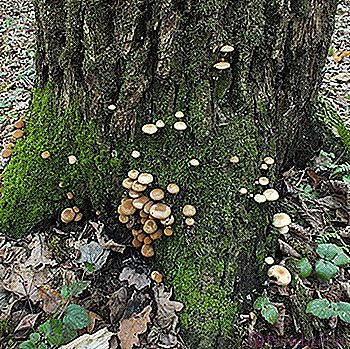
Category:
Hat (diameter 3-7 cm): usually yellowish or light brown, with a slight tubercle and often cracked and uneven edges. It has the shape of a bell, which eventually changes to almost flat. Dry and smooth to the touch.
Leg (height 3-11 cm): slightly lighter than the cap, hollow, dense and curved, with a mealy bloom along the entire length. Slightly velvety to the touch.
Plates: light beige, over time they become rich brown. They adhere firmly to the leg.
Flesh: brownish, soft, thin, watery. No pronounced odor, the taste is very bitter.
Doubles: none.
The psatirella water-loving mushroom grows from late August to early November in Eurasia and North America.
Other names: hydrophilic psatirella, hydrophilic fragile, spherical psatirella, watery pseudo-foam.
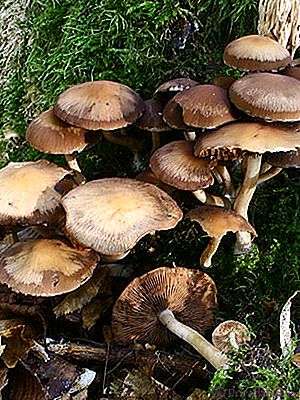
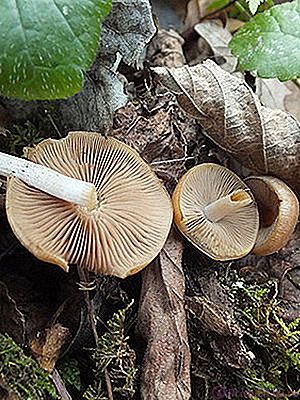
Where can you find it: on damp stumps and the dust of dead deciduous trees.
Eating: due to low taste properties, it is practically not used.
Application in traditional medicine: not applicable.
Psatirella Candolla
Category: conditionally edible.

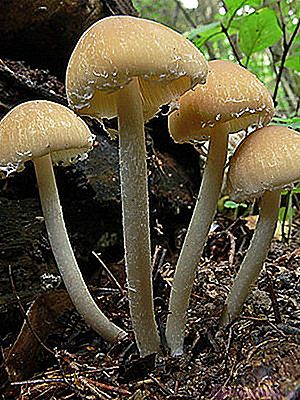
Hat (diameter 4-10 cm): creamy or light brown, very fragile, over time it changes from a hemispherical or bell-shaped to almost spread. Young mushrooms of psatirella Candoll may have small brownish scales. The edges are wavy, covered with cracks; there is usually a small tubercle in the center.
Stem (height 4-11 cm): very smooth, usually white, occasionally brown. It has a slight thickening at the base and slight pubescence along its entire length. Like the hat, it is very fragile.
Plates: frequent and narrow, adhere tightly to the stem. Young mushrooms are light, old ones are dark brown.
Flesh: brittle, white. The subtle scent can only be felt at very close range.
Doubles: brown-gray psatirella (Psathyrella spadiceogrisea), which has a darker cap and does not grow in or near trees, but exclusively in the grass.
Application in traditional medicine: not applicable.
Other names: Candoll's pseudo-froth, Candoll's fragile girl.
The psatirella Candoll mushroom grows from late May to mid-October in the countries of the Eurasian continent and North America.
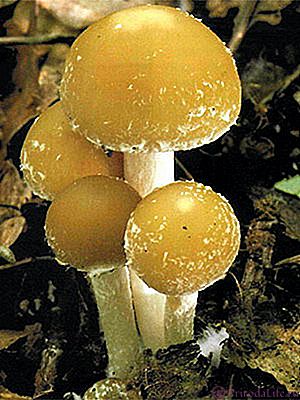
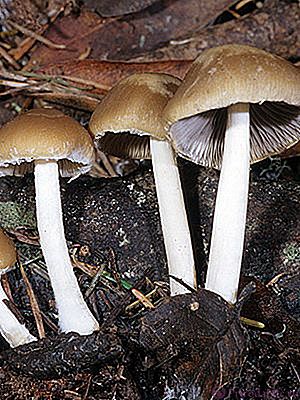
Where can you find it: on stumps, next to or on trees. Almost always found only in deciduous forests.
Eating: practically not consumed, as it requires complex heat treatment.
Psathyrella conopilus
Category: inedible.
Leg (height 6-22 cm): hollow, very fragile, white.
Flesh: thin, light brown.
Plates: gray in young mushrooms, almost black in old ones.
Hat (diameter 3-8 cm): yellow, brown or brown, conical. Smooth, with fine grooves.
The usual conical shape of the cap with characteristic grooves for the psatirella conical satyrella (Psathyrella conopilus)
Doubles: none.
When it grows: from early August to mid-October in Europe and the Far East.
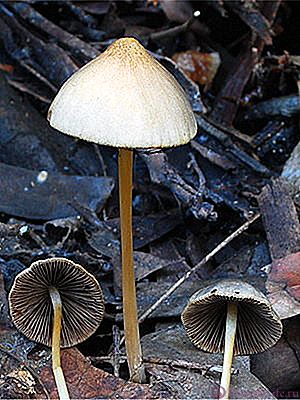
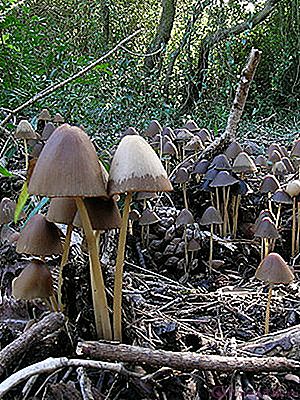
Psatirella conic grows on garbage or sawdust in parks, on roadsides. It can often be found in urban areas.
Eating: not consumed.
Application in traditional medicine: not applicable.
Other names: conical brittle, blackish psatirella.
Description of the species
The cap has a diameter of 3-6 cm, sometimes up to 9 cm, at first bell-shaped, later convex, later convex-outstretched. A distinctive feature of the species is at first a whitish-yellowish, later with purple edges, a cap with white flakes along the edge and an even white-cream leg. In addition, thin radial fibers are often visible on the surface of the cap.
The stem has a height of 3-8 cm, a thickness of 3 to 7 mm, fibrous, slightly widened near the base, brittle, white-cream with a weak flocculent bloom in the upper part.
Flesh: at first whitish, later yellowish, in young specimens without a special smell and taste, in mature and old mushrooms - with an unpleasant odor and bitter taste.
The plates are adherent, frequent, narrow, at first whitish, later gray-violet, gray-pink, dirty brown, gray-brown or dark purple.
Variability. The cap color can range from cream-white to yellowish to pinkish-cream in juveniles and yellow-brown and purple-edged in mature specimens.
Similar species. Psatirella Candolla in shape and size is similar to the golden yellow plyute (Pluteus luteovirens), which is distinguished by a golden yellow cap with a darker center.
Conditionally edible, since only the youngest specimens can be eaten and no later than 2 hours after collection, in which the color of the plates is still light. Mature specimens produce black water and a bitter taste.
Description
- Psatirella Candolla is considered a conditionally edible fruiting body, as mentioned earlier. The top grows up to 10 cm in diameter, maximum, is painted in beige or cream tone. It is fragile, changes over the course of the life cycle, becoming not round, but almost flat. Young specimens are sometimes endowed with a brown scaly structure. The edges of the apex are uneven, wavy, all with cracks. There is a bump in the center of the hat.
- The plates on the back of the hat are located next to each other, they stick to the base and are pigmented from light to dark brown. It all depends on the age of a particular fruiting body. The leg grows up to 10 cm in height, it is smoothed and white. May be brownish on rare occasions. A seal is seen at the bottom. The leg itself is weak and often breaks.
- The soft part of the whole mushroom is painted with a whitish tone. A subtle aroma emanates from it. This type of mushroom has a twin called brown-gray psatirella. This twin is dark, growing next to trees in the grass. The Candoll mushroom is not used in folk medicine. It has other names, such as fragile or false froth.
- Growth begins at the end of the spring season and continues until mid-autumn. The nature of the growth is colonial, but the groups are not too voluminous. It is necessary to look for mushrooms in North America and Eurasia. Fruit bodies grow directly on tree trunks and stumps. Often found in larch trees, as well as parks, courtyards and gardens. Heat treatment after harvest is very difficult, so the mushroom is practically not consumed as food.
Differences
This variety has distinctive characteristics. The cocoon, which remains after birth, is on the hat of the fruiting body. If these remains of the blanket are not present, then it is necessary to study the place of growth.Mushrooms settle on dead areas of trees, in particular on stumps. Also, there is no ring on the base.
If we compare Candoll, for example, with Agrotsibe, then the following should be said. Our variety has a darker spore powder. And this variety differs from other psatirella in its large size and light tone.
Also, the peculiar variability of Candoll should not be overlooked. External data may change depending on climatic conditions, temperature regime in the morning and evening hours. Age and habitat are of no small importance. But you should know for sure that you will not confuse this species with edible mushrooms.
Psatirella velvety: edibility, where it grows, photo, is it possible to eat
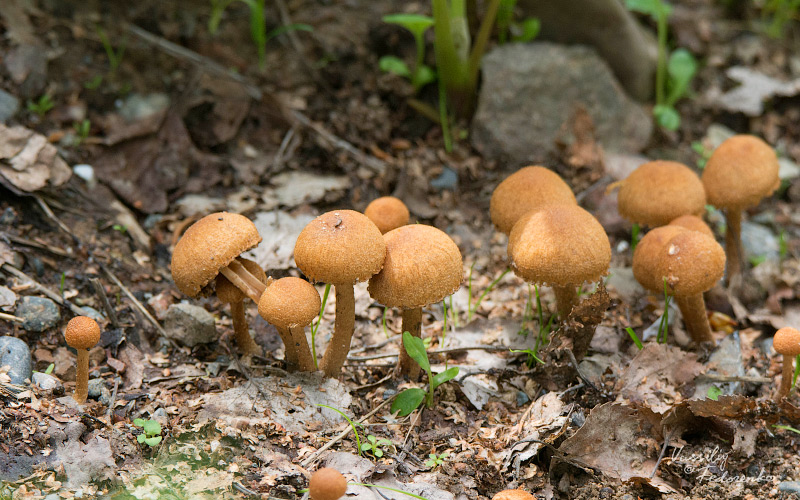
Insert-mushroom-tree Synonyms: Agaricus lacrymabundus Bull., 1785 Psathyra lacrymabunda (Bull.) P. Kumm., 1871 Hypholoma lacrimabundum (Bull.) Sacc., 1872 Geophila lacrymabunda (Bulliard. lacrymabunda (Bull.) Quél., 1886 Hypholoma lacrymabundum (Bull.) Sacc., 1887 Psathyrella lacrymabunda (Bull.) M.M. Moser ex A.H. Sm., 1953 Agaricus macrourus Pers., Abb. Schwämme, 1793
Etymology: Lacrymaria (Latin lacryma - tear) lacrymabunda (Latin lacrimatis - watery; Latin abundans - abundant).
Cap: 3.5-6 cm in diameter, ovoid, convex, more or less prostrate with a tubercle, with a sterile edge, dirty honey, covered with yellow-brown scales, silky fibrous.
Plates: adherent, alternating with three intercalated, rather rare, chocolate, dark purple-brown, with a white edge, watery in damp weather, tearing off.
Leg: 4.3-6 x 0.5 cm, even or slightly thickened at the base, off-white, fine-fluffy-scaly, below woolly-scaly, with brown fibers, cotton-like inside, with a weakly pronounced cavity and ring.
Pulp: cotton-like, wood-colored, slightly bitter, with a weak mushroom odor.
Spores: 8-11 x 5.5-6.5, lemon-shaped, almond-shaped, smooth, dark brown.
Cystids: 48.4-70.5 x 8.4-10.5 microns, cylindrical, clavate, capitate, smooth, thin-walled.
Habitat: grows in deciduous forests, in grass, on the outskirts of forest paths, in park alleys, in forest glades and vegetable gardens.
Season: May-October.
Distribution in Kazakhstan: Almaty region.
Habitat: Europe, Asia.
Edible: not edible.
- Samgina D.I. “Flora of spore plants in Kazakhstan. Volume XIII. 2. Agaricales "," Science "Alma-Ata, 1985.
- Knudsen H. Lacrymaria. - In: Knudsen, H. & Vesterholt, J. (eds.): Funga Nordica, 2008. P. 583-585.
- MycoBank.org
Morphology
The fruiting bodies are small or medium-sized, with a central stem position.
The cap is thin, hygrophane, at first spherical, bell-shaped or cone-shaped, can open up to flat, the edges are often grooved, the color is from whitish to various brown shades.
The pulp is thin, fragile.
The stem is long and thin, brittle, fibrous, with a cavity, usually the same color as the cap or lighter in color. The surface can be felt or scaly.
The plates are adherent or loose, at first light, then darken and become brown, violet-brown or black, usually with a lighter edge.
The remains of the bedspread are noticeable on the surface and especially along the edges of the cap, cobweb or filmy, the ring and volva are usually absent, there is rarely a ring on the leg.
Dark brown, purple or almost black spore powder.
Spores are dark purple to black, usually smooth, with occasional germination. There are cheilocystids, their shape can be varied: bottle-shaped, saccular, clavate, with a coracoid outgrowth, sometimes inlaid with crystals.
Spherical psatirella
Psatirella spherical (lat.Psathyrella piluliformis).
Hat:
In youth, the cap of the mushroom has a convex hemispherical or bell-shaped shape, then it opens up and becomes a half-spacer. Scraps of a private bedspread can often be seen around the edges of the hat. The diameter of the cap ranges from two to six centimeters. The hat has a hygrophilous texture. The color of the surface is highly dependent on humidity, varying from chocolate, in fairly humid conditions, to cream in dry weather.Often the cap is colored with peculiar areas.
Pulp:
the flesh of the cap is whitish cream in color. Has no special taste or aroma. The pulp is not brittle, thin, relatively tough.
Plates:
frequent, adherent plates in a young fungus have a light color. As the spores mature, the plates darken to dark brown. In damp weather, the plates can give off droplets of liquid.
Spore powder: purple-brown.
Leg:
smooth, hollow, but quite dense leg, from three to eight centimeters high, up to 0.7 centimeters thick. Whitish in color. There is a false ring at the top of the leg. Often the stem is slightly curved. The surface of the leg is silky, smooth. The upper part of the leg is covered with a powdery coating, the lower part has a light brown color.
Spreading:
Psatirella globular is found on woody remains. It grows on stumps in deciduous or coniferous forests, as well as around stumps and on damp soils. Grows in large colonies, connecting in bunches. Fruiting from early June to mid-October.
Similarity:
From other types of mushrooms of the genus Psatirella, this mushroom is distinguished by the brown color of the cap and the growing conditions. This is just one of many small brown mushrooms. It has a similarity to Psatirella gray-brown, but it is larger and does not grow so heap. The summer honey agaric has a similar color of the hygrophilous cap, but in this case, the differences are much greater than the similarities. It is worth noting another similar small brown mushroom that grows in late autumn in the same conditions, practically on the same stumps as Psatirella globular. The main difference between this mushroom is the color of the spore powder - rusty brown. Recall that Psatirella has a dark purple powder. Of course, we are talking about Galerina Okaymelnaya.


